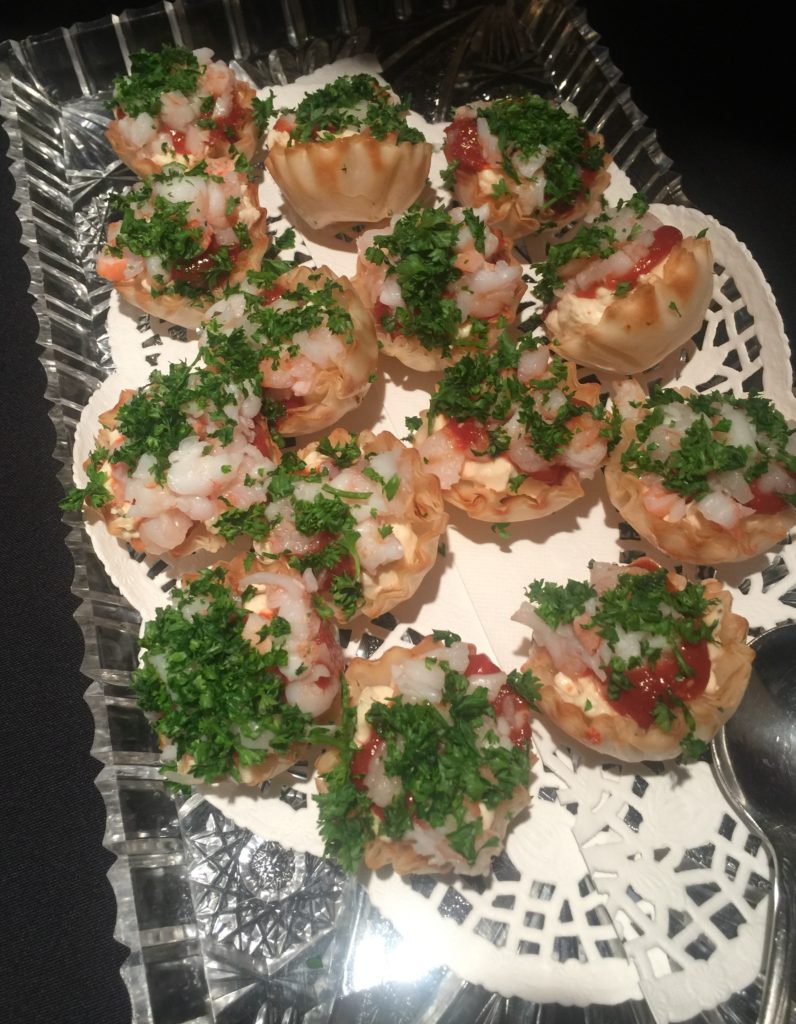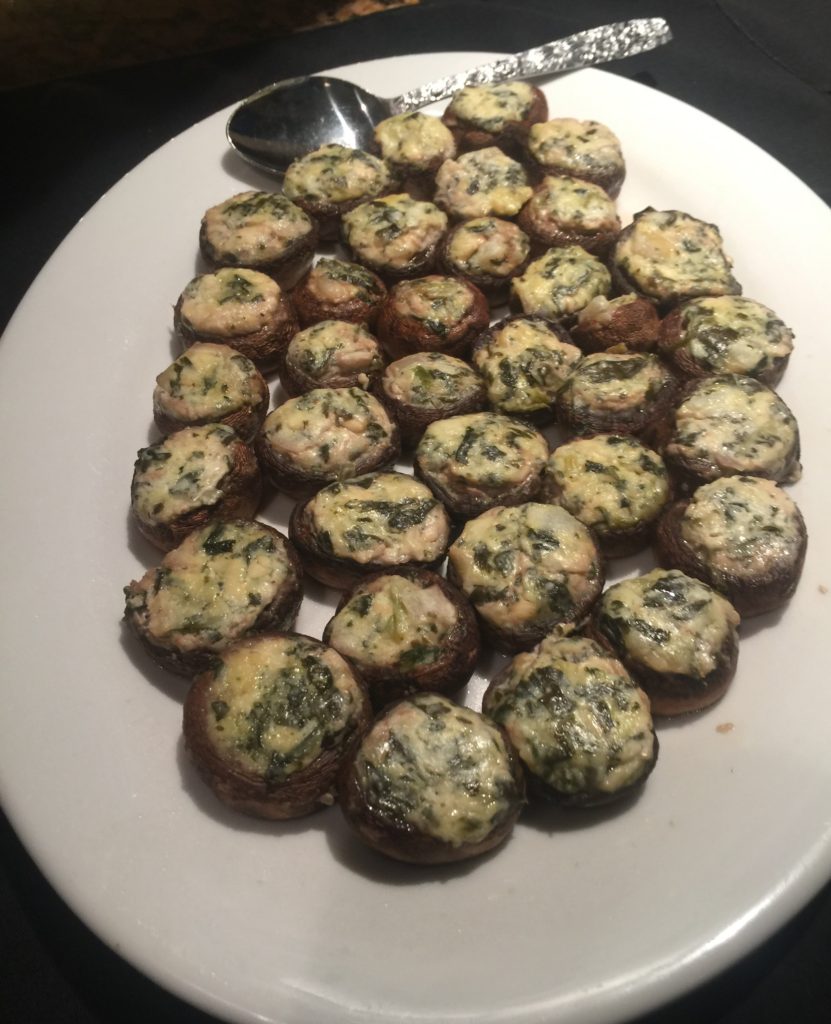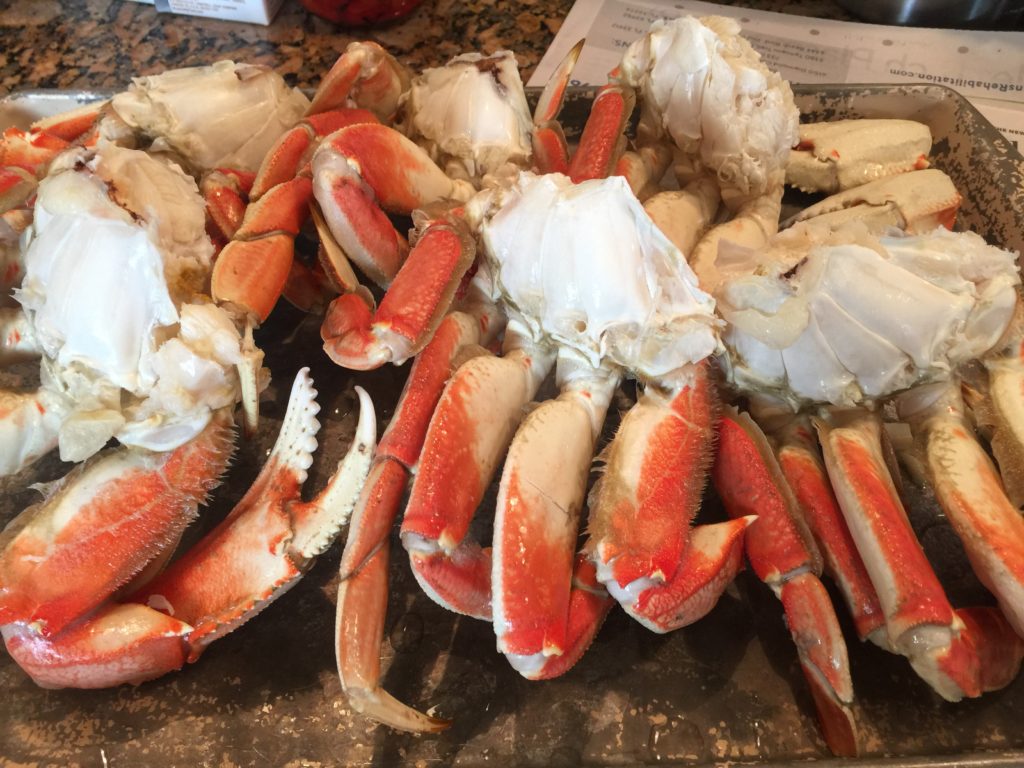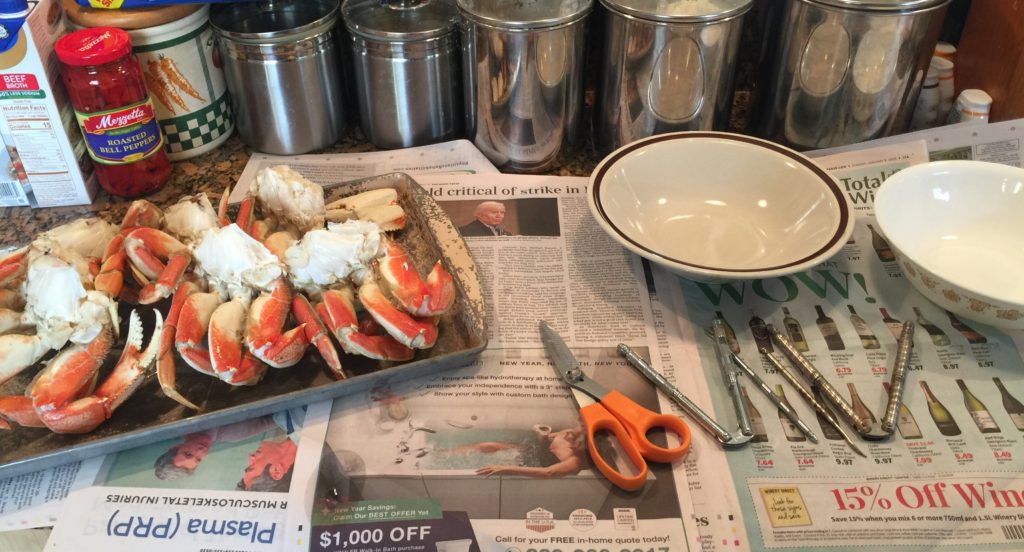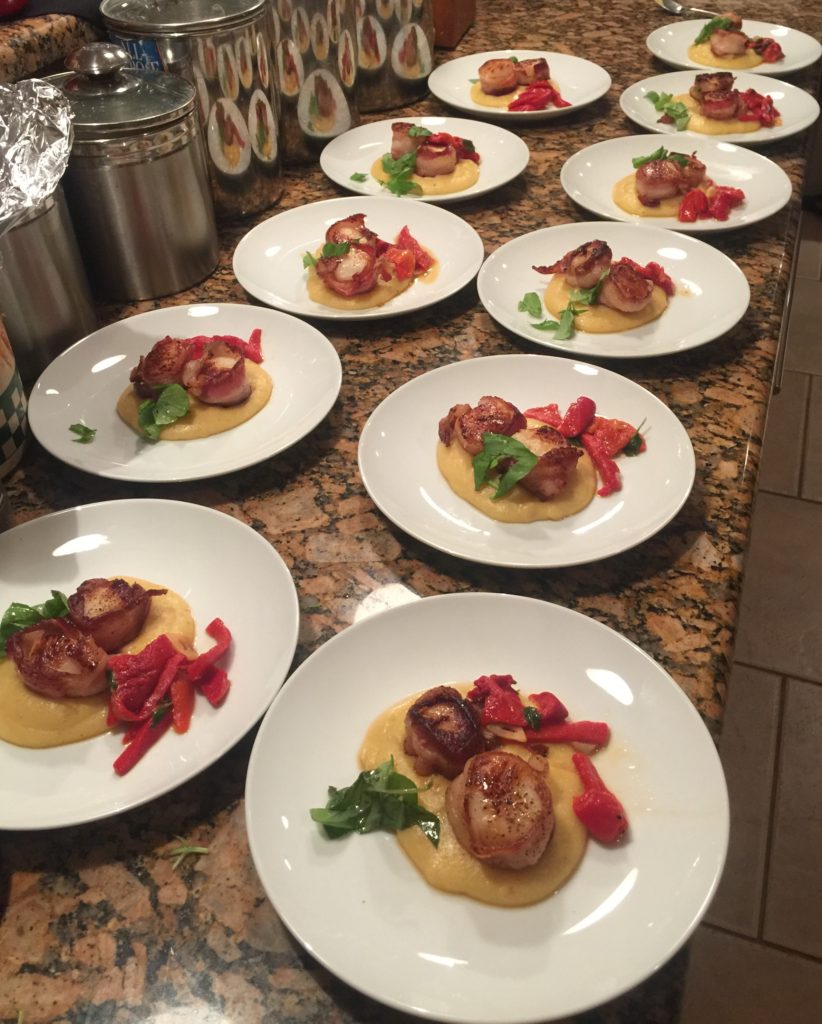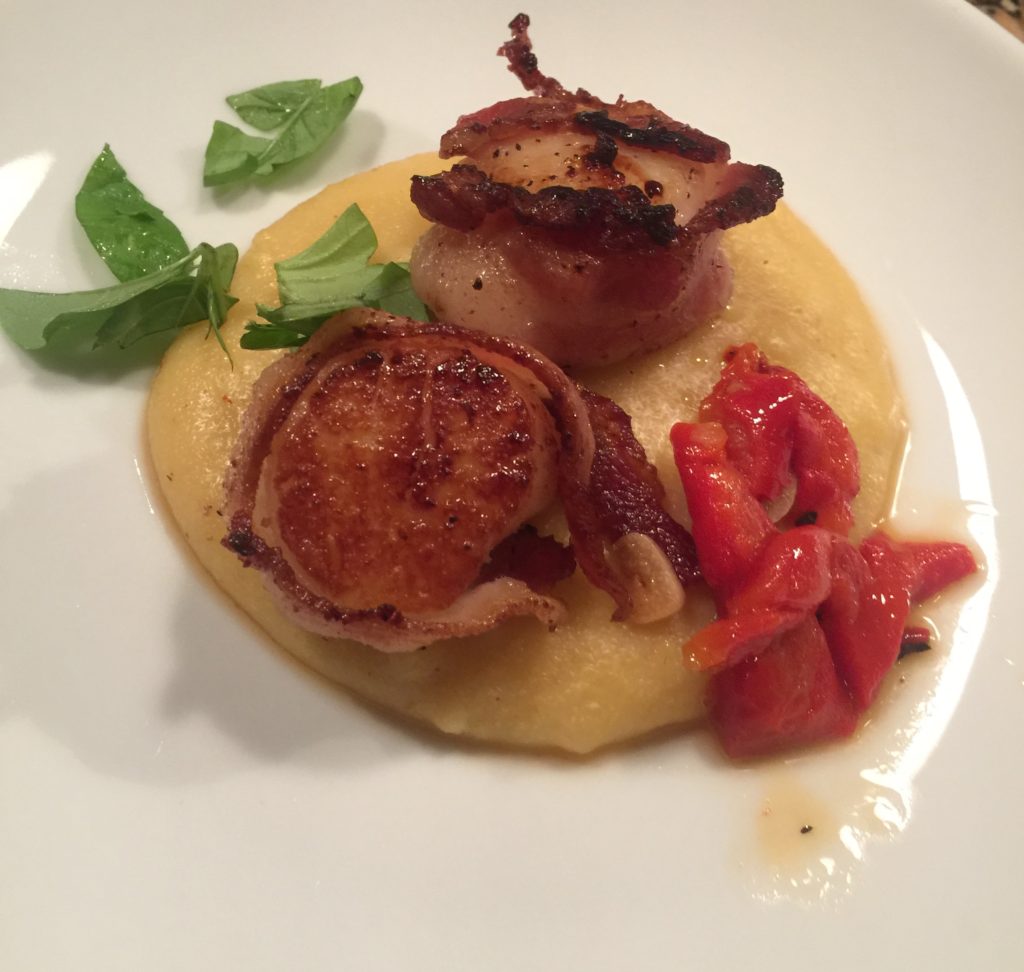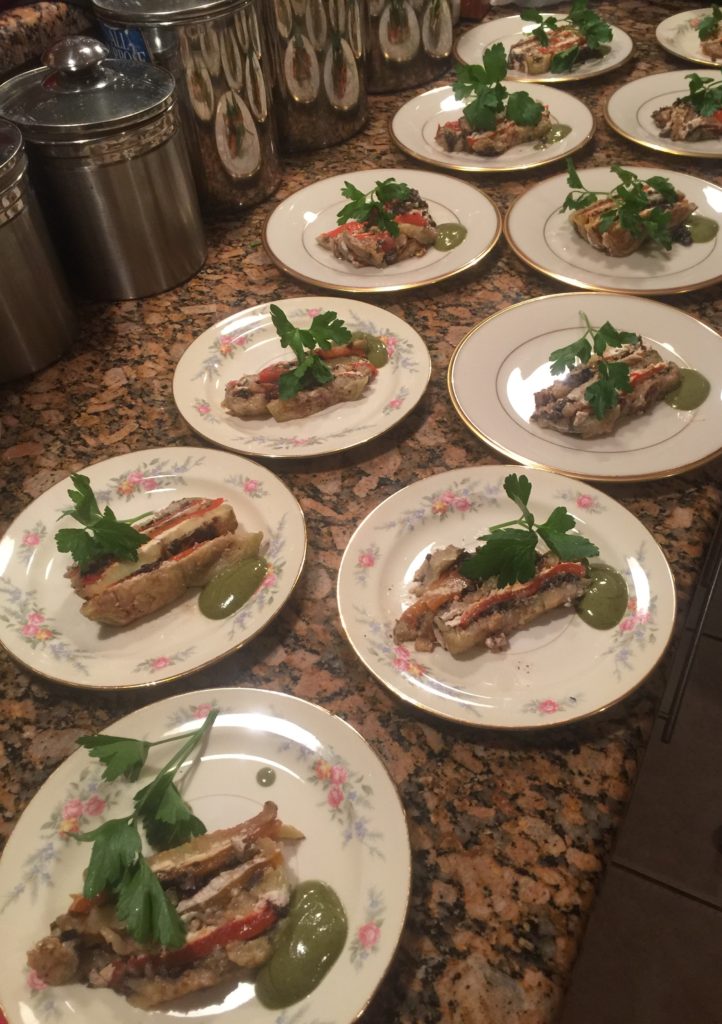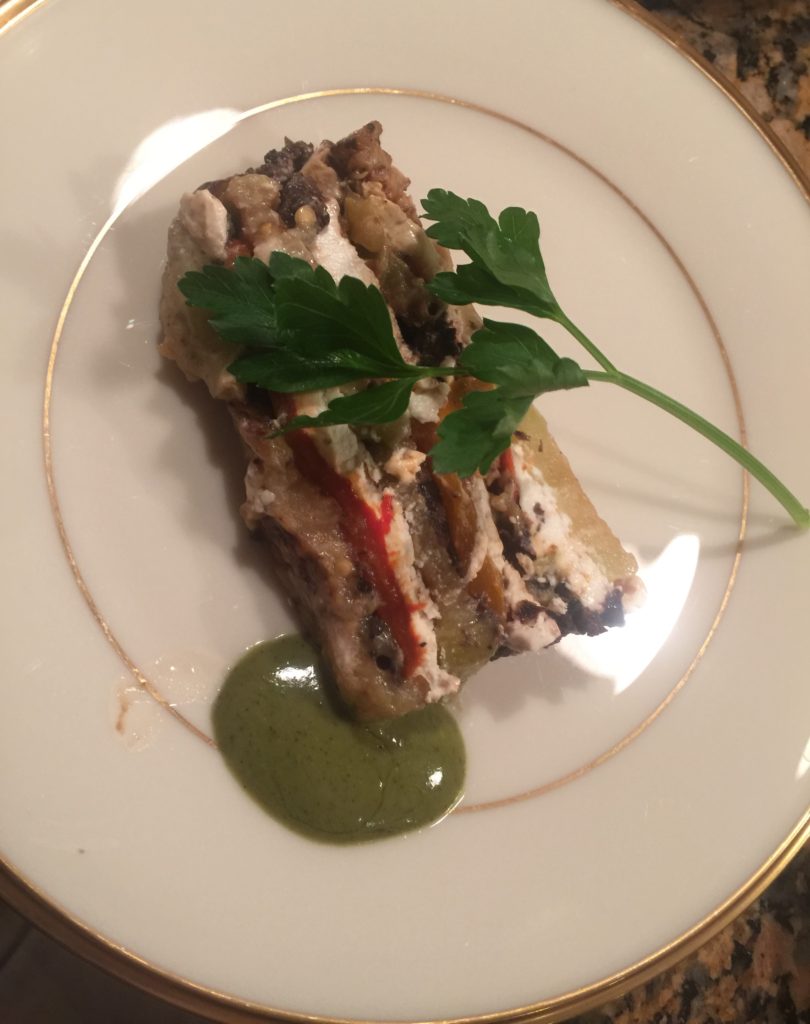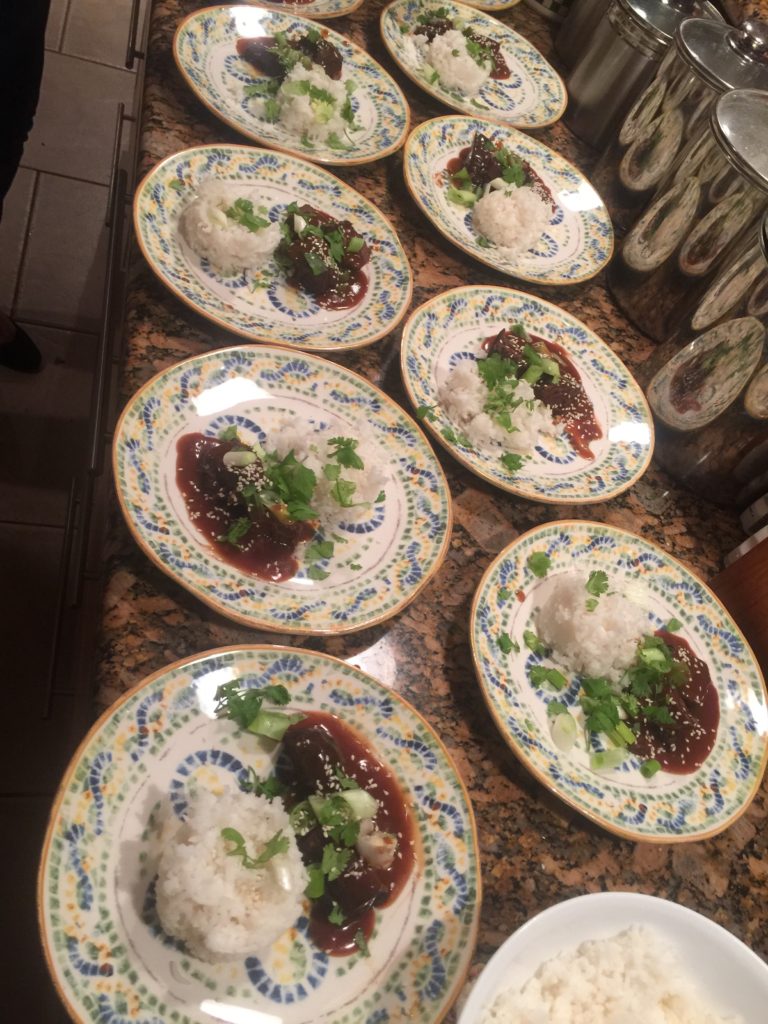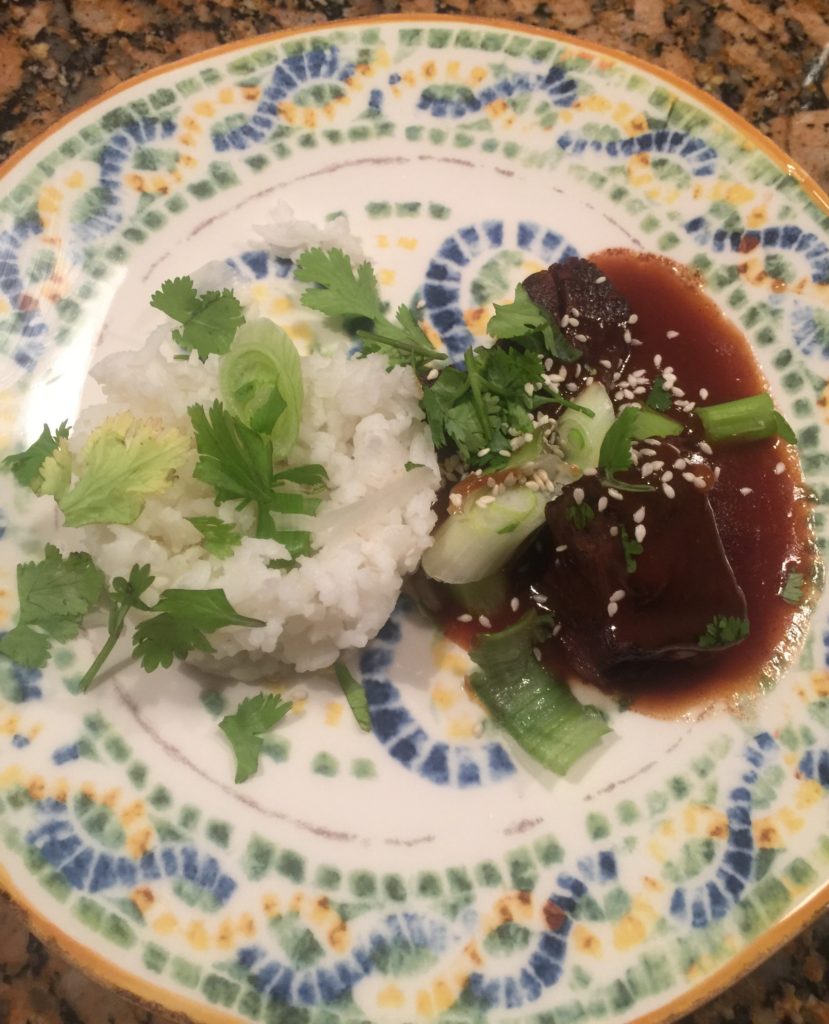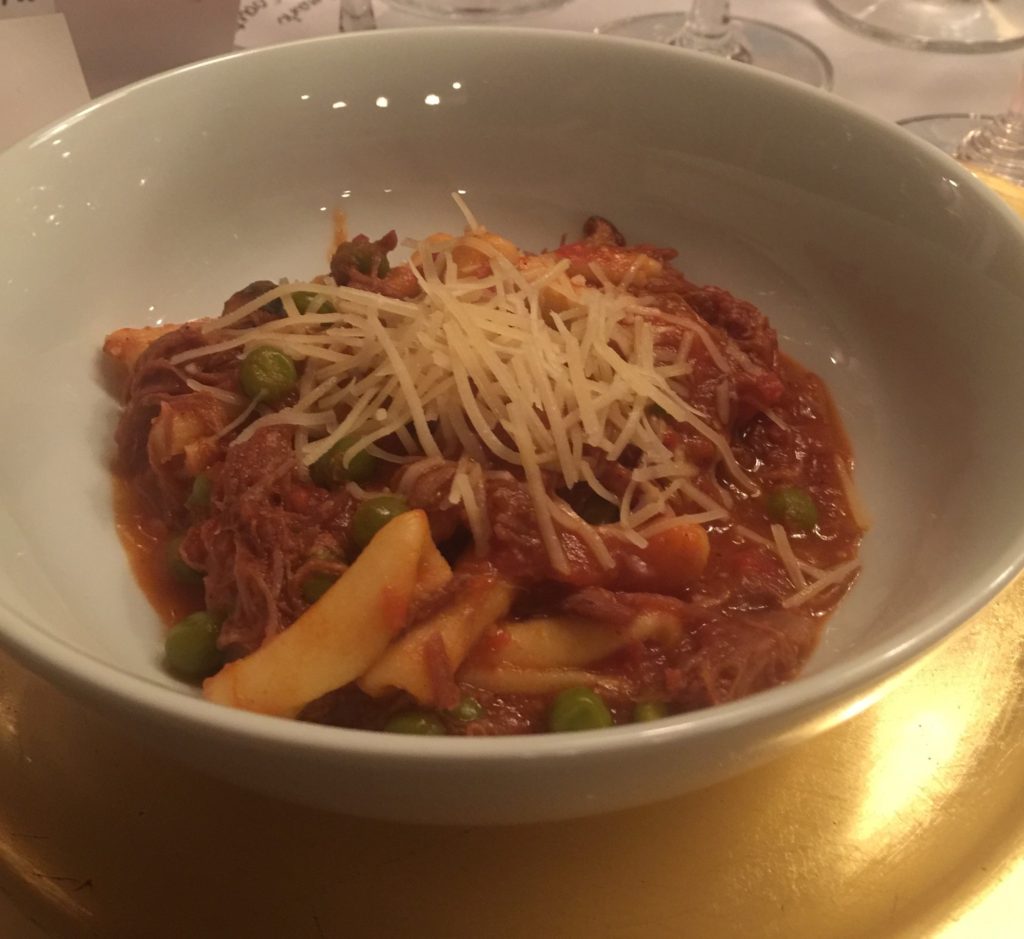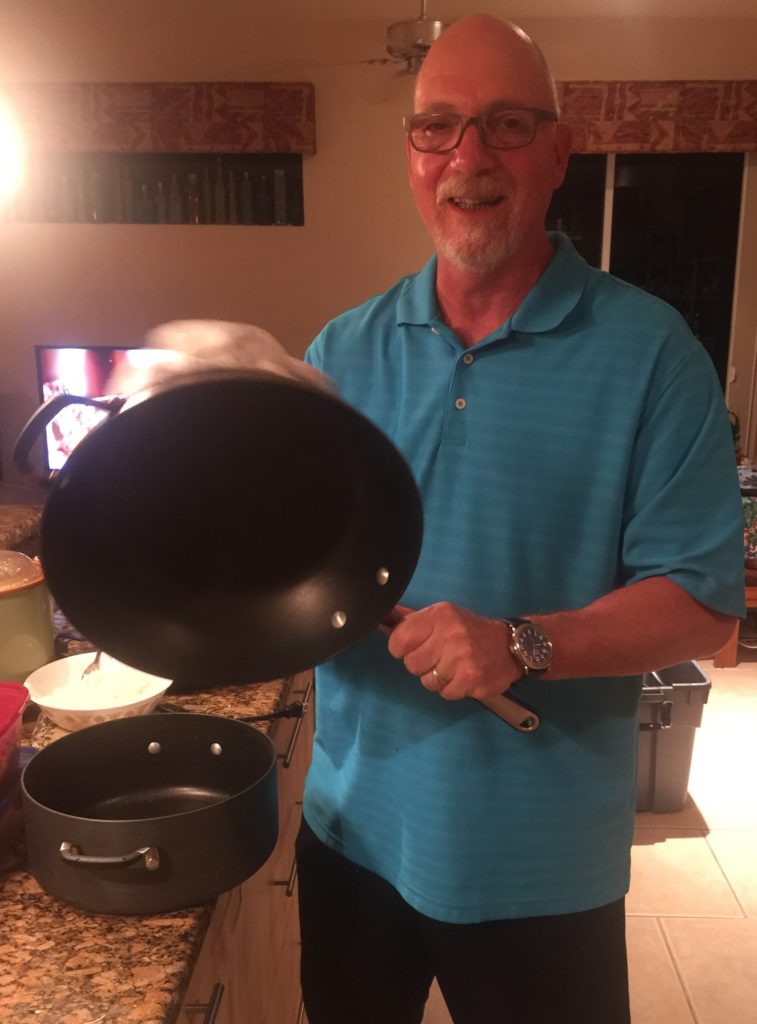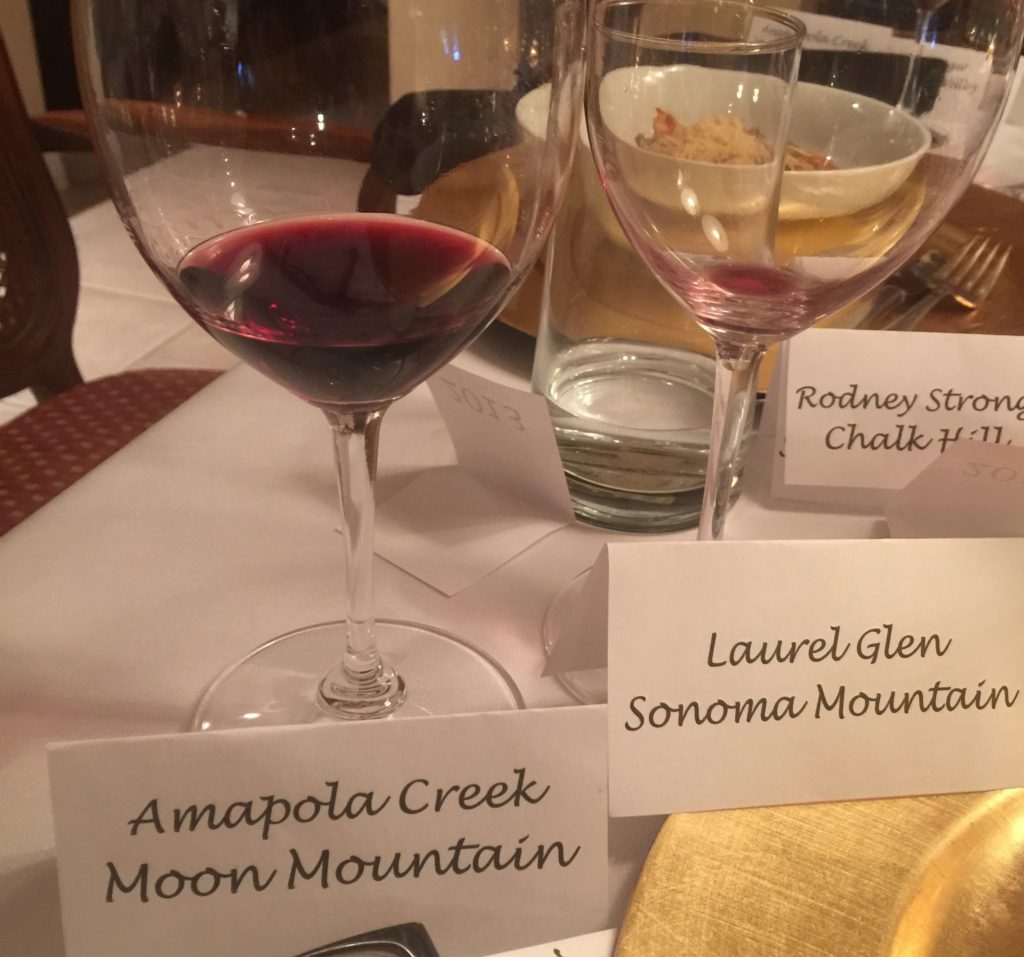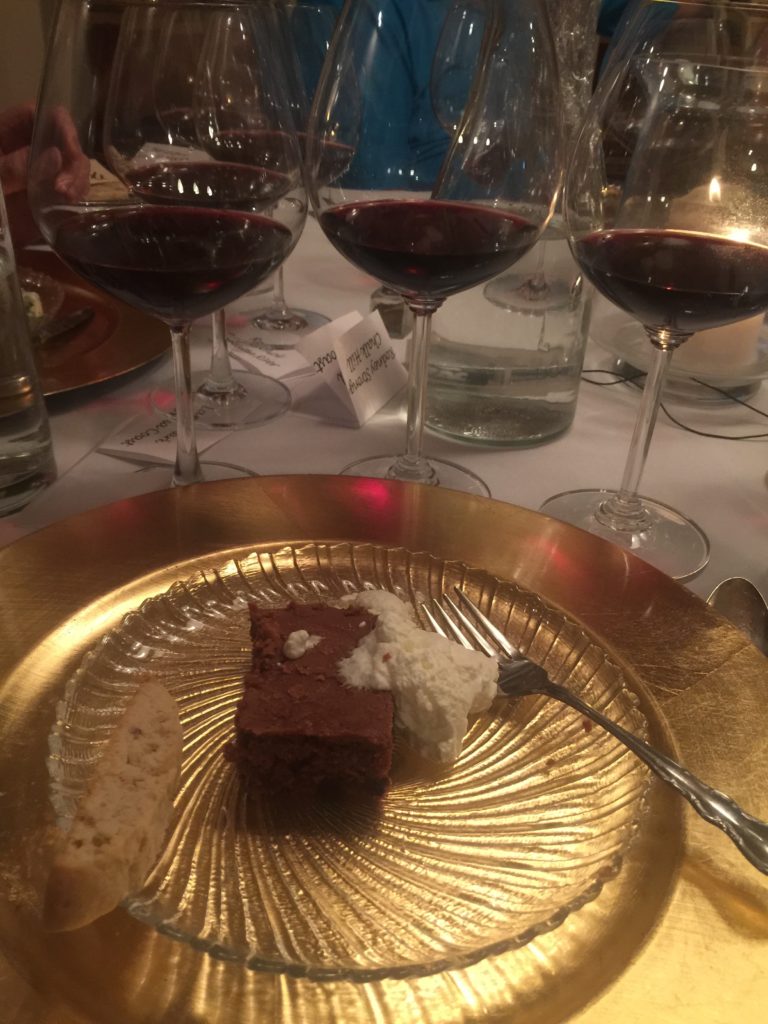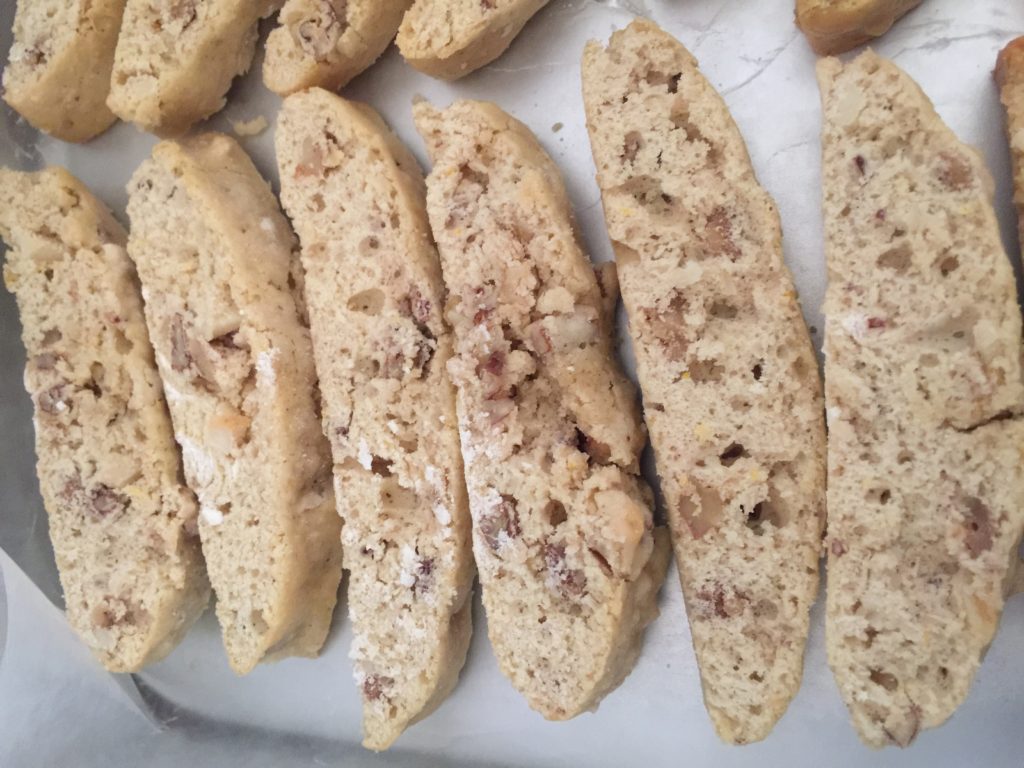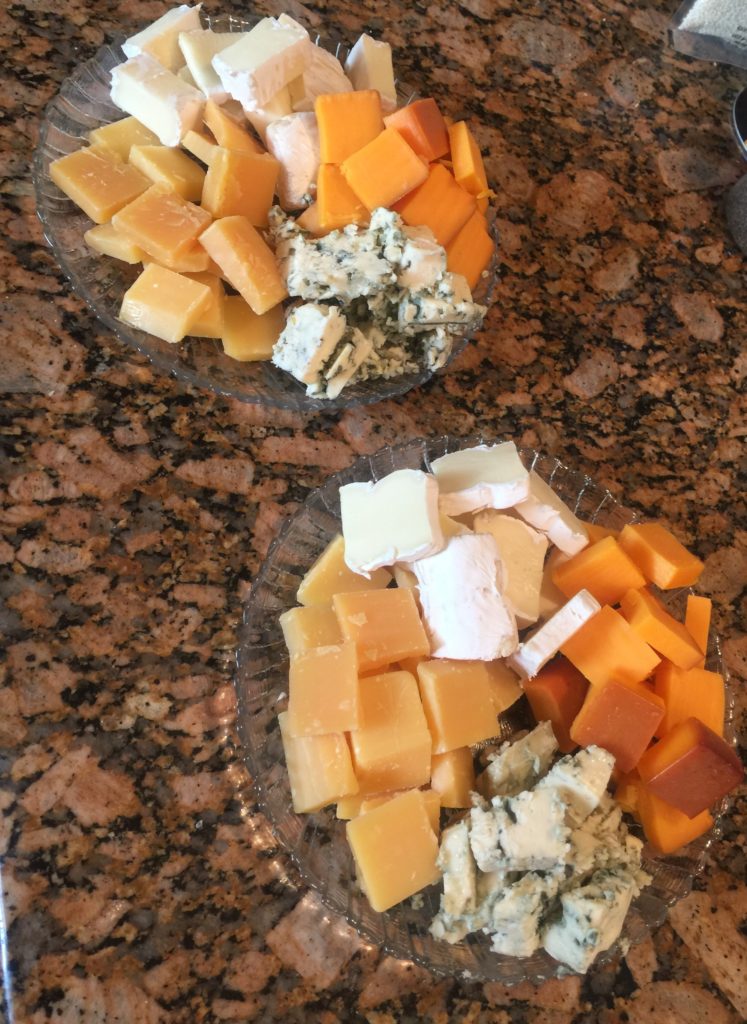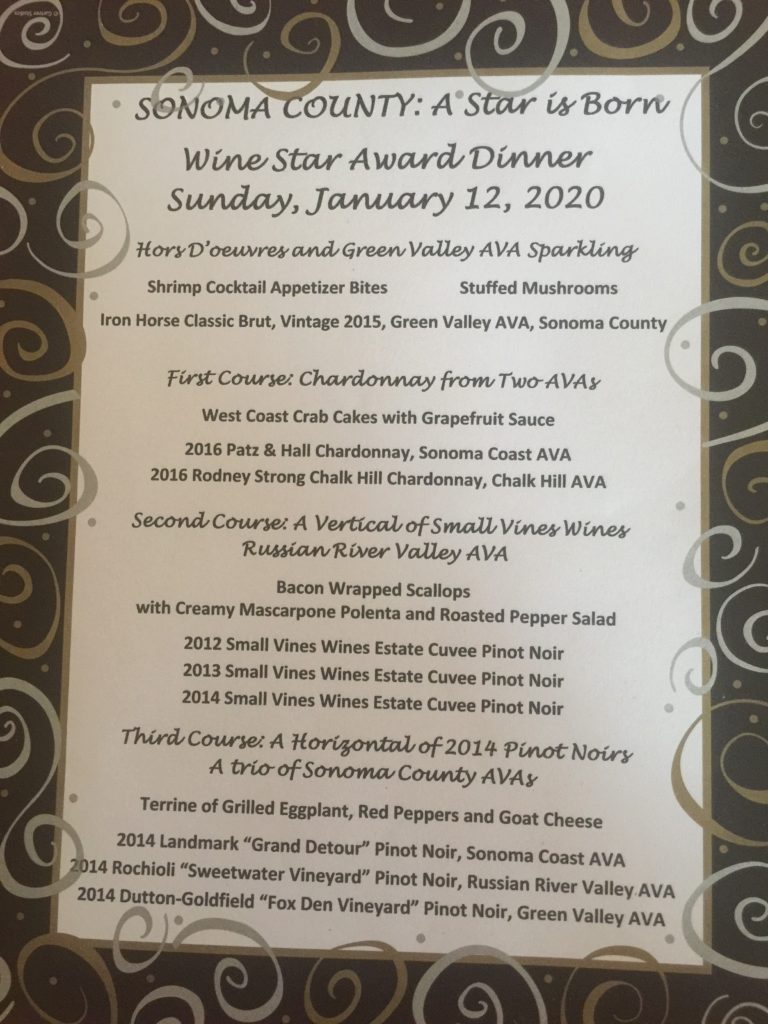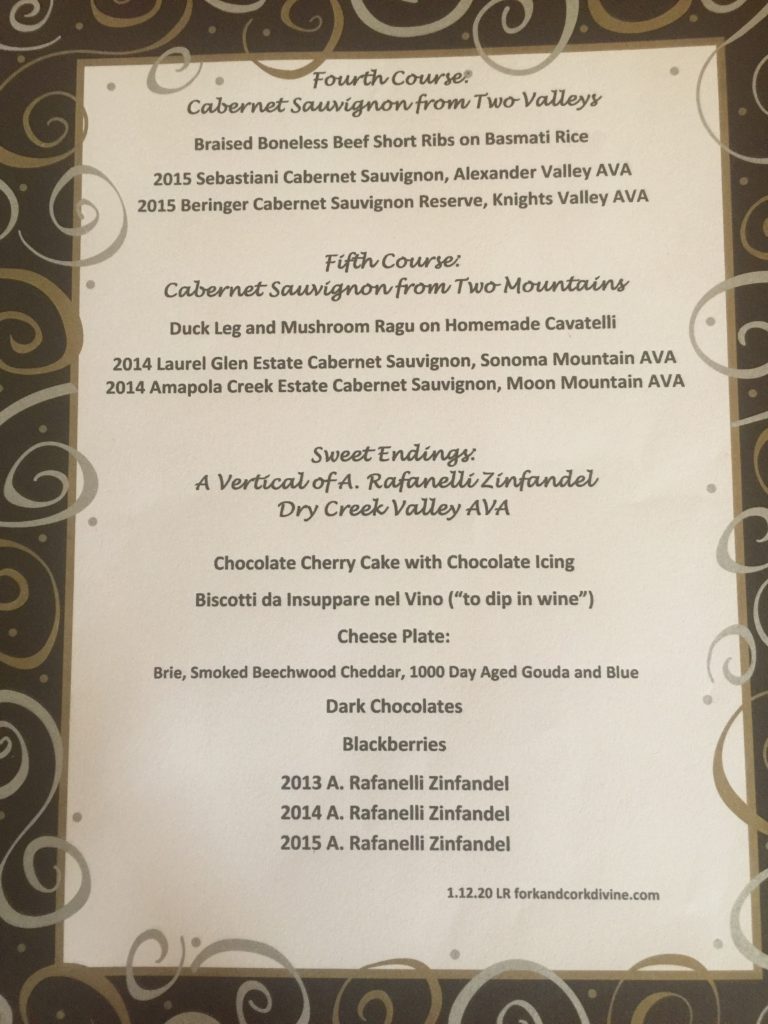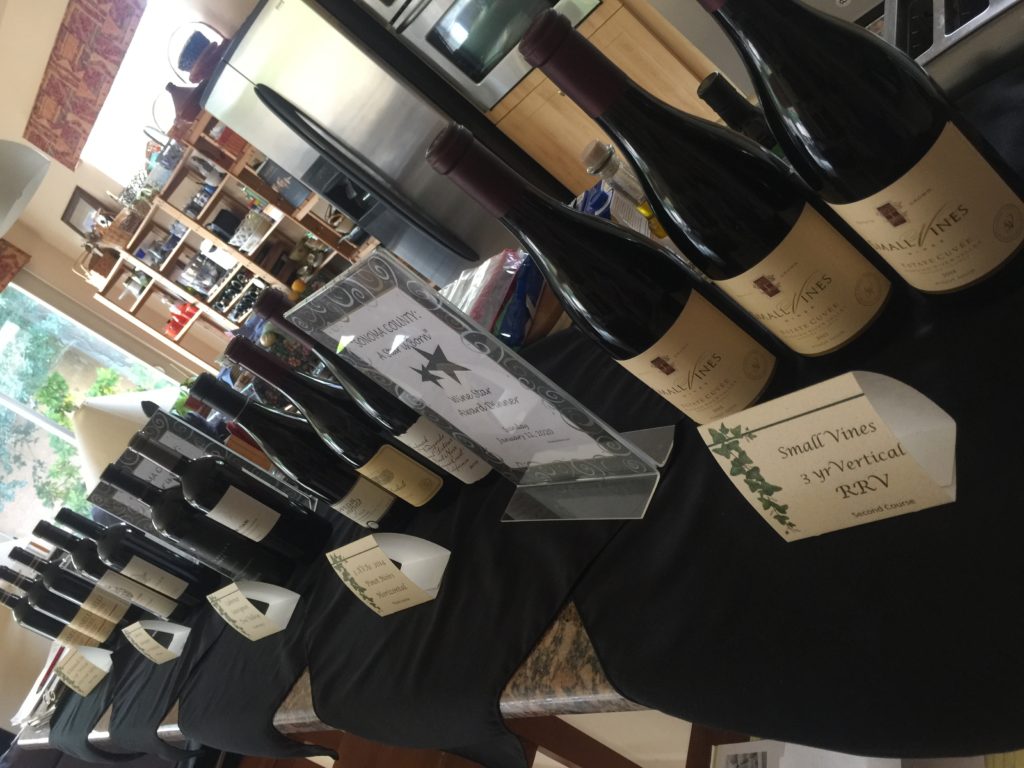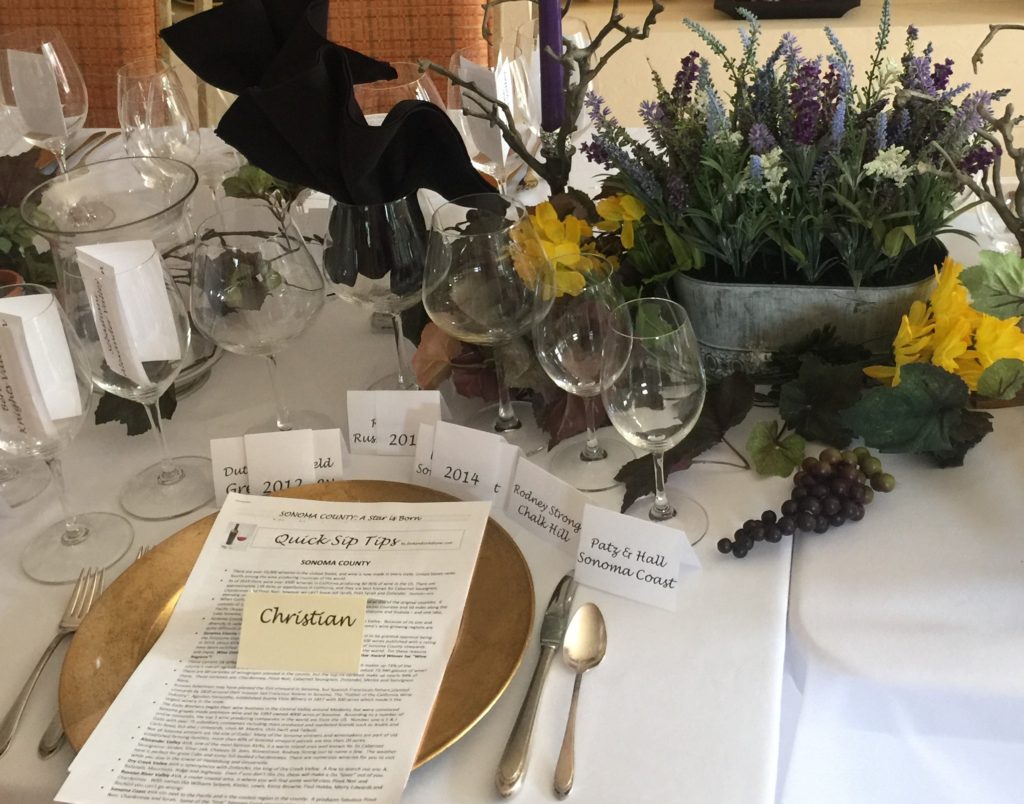The stars came out over our table for twelve and sparkled throughout the evening as we enjoyed appetizers, six courses and sixteen Sonoma County wines. I am fairly sure there were even some shooting star moments. This was the wine dinner event we had been patiently waiting for — our celebration of the 2019 Wine Star Award winning “Wine Region of the Year” — SONOMA COUNTY.

Sonoma County’s 425 or so wineries are best known for producing Chardonnay, Pinot Noir, Cabernet Sauvignon and Zinfandel, many of which receive 90 or more points from wine reviewers. You will also find excellent Merlots and Sauvignon Blancs. Our mission was to select wines that would showcase the differences between some of the awesome 18 AVAs of Sonoma County and confirm that the county overall produces some amazingly good wines……..and at reasonable prices!
There are over one million acres of land in Sonoma County making it twice as large as Napa Valley. Because of it’s size, there is plenty of diversity in the wine regions ranging from coastal cool with fog coming in from the ocean or bay to mountains, riverbeds, plains, benchlands and valleys many with quite different climates and soils. We tried to feature as much of this diversity as possible. Our first star was sparkling wine from Iron Horse in Green Valley, followed by Chardonnays from Sonoma Coast and Chalk Hill. Then we moved on to Pinot Noirs and featured them in two ways beginning with a three year vertical from the same winery in Russian River Valley, then followed up with a 2014 vertical of Pinot Noirs from three different AVAs -Russian River Valley, Green Valley and Sonoma Coast. We were dazzled by Cabernet Sauvignons from Alexander Valley and Knights Valley, Moon Mountain and Sonoma Mountain. Just when we thought we couldn’t drink another drop, there was a superstar vertical of three Zinfandels from Dry Creek Valley! More information about the various AVAs is coming as we work our way through the dinner menu.
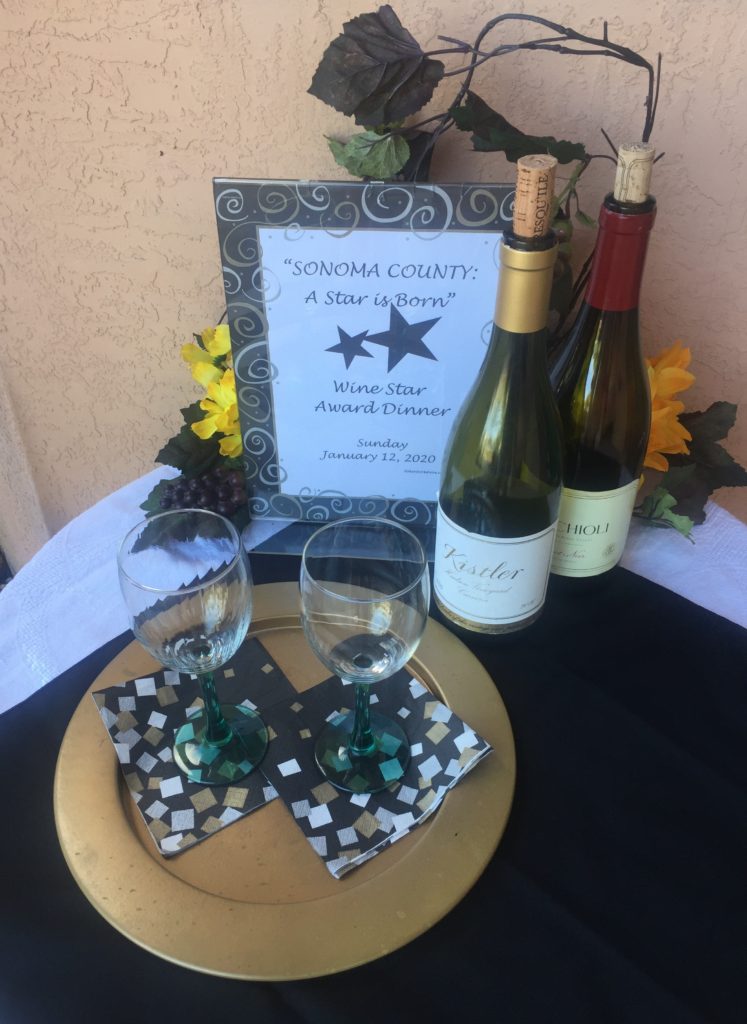
The menu items were all selected to compliment the wines, some of them from recipes of several of the great chefs or wineries in the county. Our guests are all excellent cooks in their own right; some of them are trained professional chefs while others honed their skills in home kitchens. I believe that the foods we served allowed our wines to shine just as their winemakers intended them to do!
Here is our menu with all of the courses, wines and many pictures. We hope that you enjoy our journey through the AVAs and wines of Sonoma County almost as much as we did.
SONOMA COUNTY:
“A Star is Born”
Wine Star Award Dinner
Sunday, January 12, 2020
Hors D’oeuvres and Green Valley AVA Sparkling
Shrimp Cocktail Bites
Stuffed Mushrooms
How do you decide on the right hors d’oeuvres to start out such a starry wine packed evening? You look for something very “classy”, elegant and just the right little one mouthful! I found several with Debbie’s Shrimp Cocktail Appetizer Bites and Chef Christian’s “world famous” Stuffed Mushrooms. You can’t go wrong with those stuffed mushrooms. Everyone who has ever been to one of Chef Christian’s wine dinners at Blue Rendezvous French Bistro on the island of Sanibel, Florida has loved loved loved those mushrooms served at occasional receptions. I had the courage to ask him to bring some, and he graciously accepted! On the other end of the culinary spectrum, Debbie had never made these magical little shrimp cocktail bites before, but they were snatched up so fast off the serving plate that I didn’t even get to enjoy one. She promises to make them again ……. just for me! According to our guests, they really complimented that Iron Horse Classic Brut sparkling wine. I’ll take their word for it, because how could they be wrong?
Iron Horse Classic Brut, Vintage 2015, Green Valley, Sonoma County
Iron Horse
Green Valley is famous for fog and slightly cooler temperatures. It was rainy and misty when we visited. The Sterlings were renovating the tasting room making our experience even more special. We were outside on the rustic deck looking down over the property with the wines set up on wooden boards.
Audrey and Barry Sterling first saw the estate in pouring rain in February 1976, thought it looked like Camelot and bought the property in two weeks. The winery is named for a train that used to cross the property, the Iron Horse. Their wines all have a sense of place specific to Green Valley, their vineyard and the vintage. They are elegant, soft and silky and full of quality and class. The sparkling wines exceed French standards for vintage quality and are of the “Grower Champagne” category. Wedding Cuvee is aged on average three years; the Classic Vintage Brut four to five and the Late Disgorged seven to eight years. The sparkling wines of Iron Horse have been served at the White House for numerous historic occasions. There are three generations of family living on the property all striving to put back more than what they take out of the land. They are certified sustainable by the Wine Institute and the Sonoma Wine Growers.
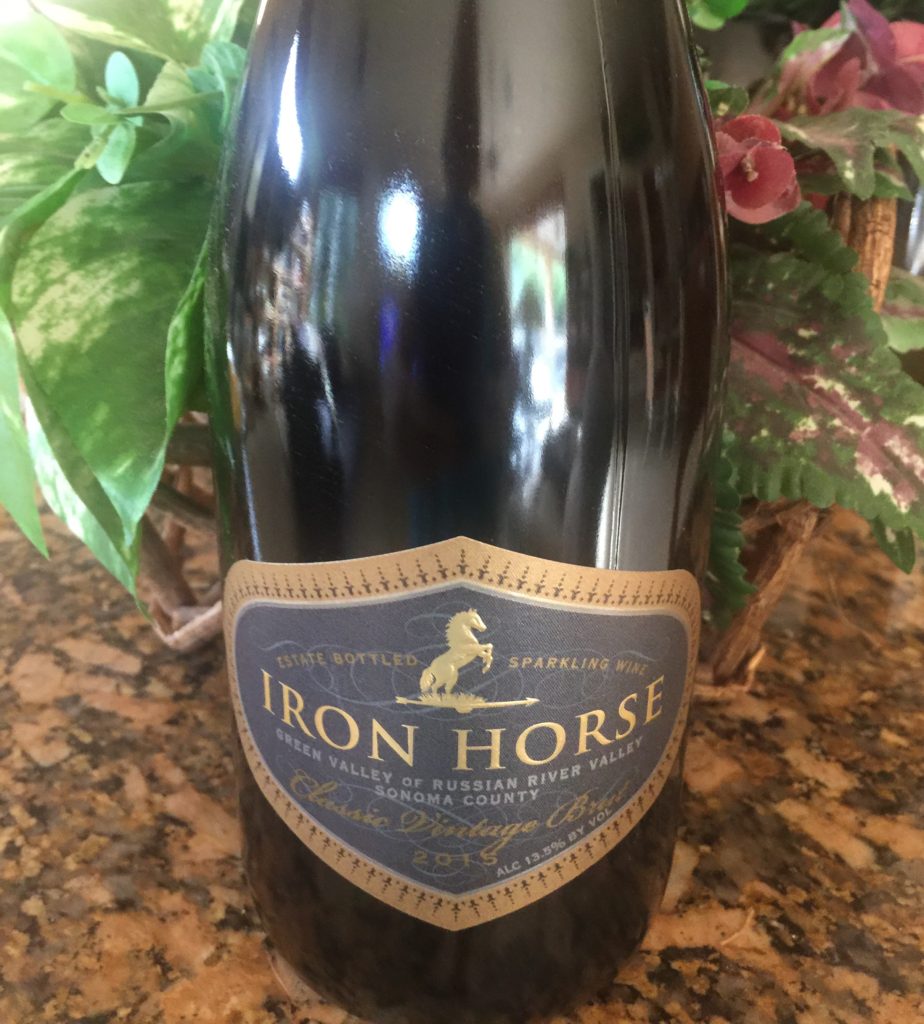
2015 Iron Horse Classic Brut, Green Valley AVA Classic Brut is the “flagship” sparkling of Iron Horse. Just 1200 cases of this 75% Pinot Noir and 25% Chardonnay blend were made for the 2015 vintage. The winemaker says it has notes of rising dough, orange marmalade and baked apple with flavors of ripe red apples, mandarin oranges and hazelnuts on the palate – all flavors unmistakably Green Valley, Iron Horse and the famous Goldridge soil. I couldn’t find any ratings yet for the 2015, but previous vintages have all been between 90 and 95 points, and our guests all gave rave reviews! This bottle cost us about $45 from wine.com
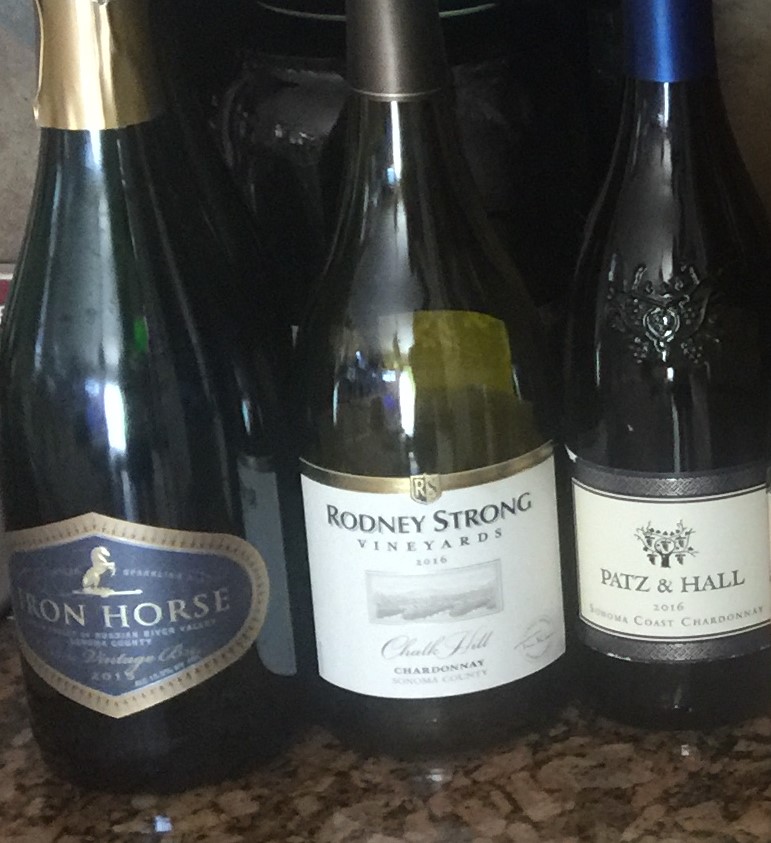
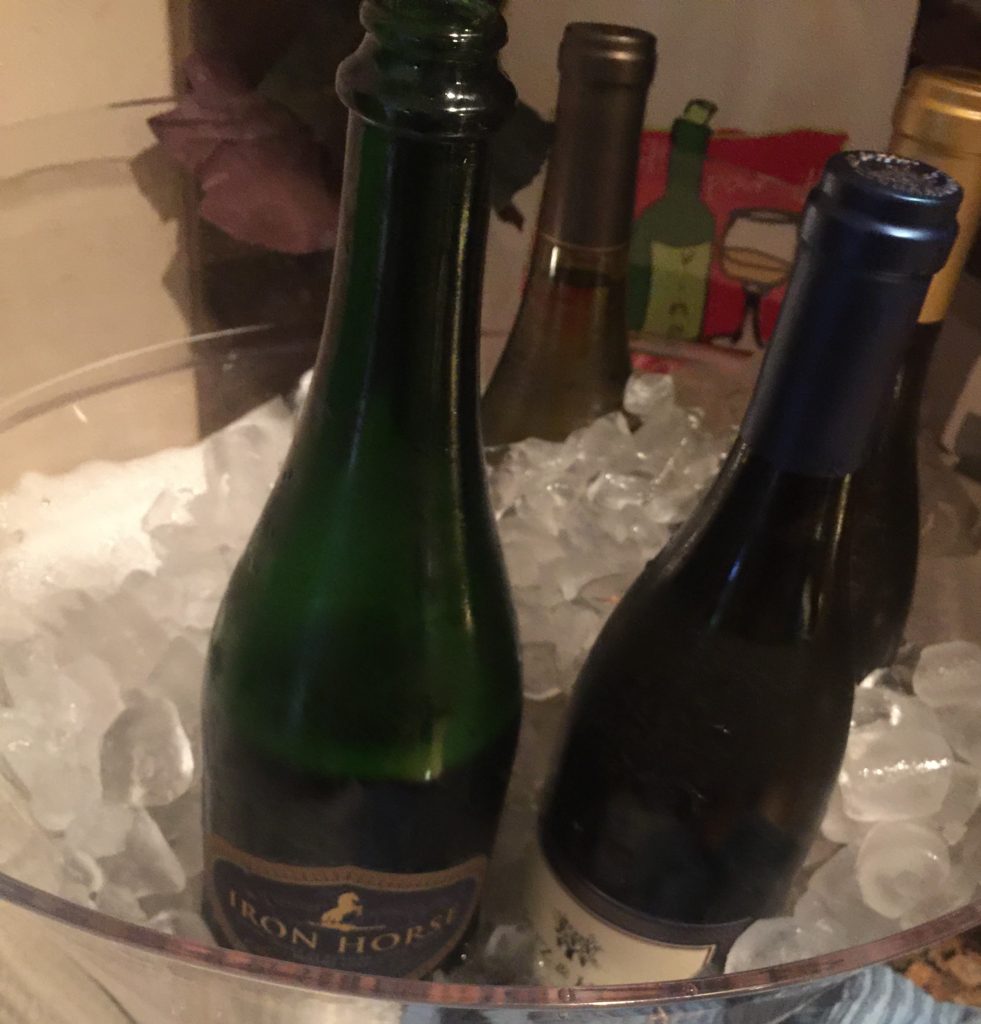
First Course: Chardonnay from Two AVAs
West Coast Dungeness Crab Cakes, Grapefruit Sauce and Ruby Red Grapefruit Section Garnish
I really like to make somewhat of a big splashy statement with our first course seated at the table, and this one really did that no “splashy crabs” pun intended! Anita, my foodie friend and guest at this dinner suggested this recipe as an option, and my first thought is “where am I going to get Dungeness crab here on the east coast”? Surprisingly to me, my local Publix supermarket had them and even on sale! So being the experienced crab picker that I am from my days of living in Baltimore and Virginia Beach, I set up my workstation and started pickin”!
Dungeness crabs, aka West Coast crab, is named after a small town in Washington State but you can get them in Pacific waters from California up the coast to Alaska. They have a more naturally sweet flavor than some other crabs. Now grapefruit is another story. I’ve complimented seafood with many an orange sauce, but grapefruit is a little rarer. However, you can’t believe what an outstanding dish this was and how well it paired with our citrusy Chardonnays from two AVAs.
The crabcakes had some Old Bay seasoning in them, thank goodness, as it is hard for me to leave that out, plus a few chives, some Dijon, a little whipping cream, an egg and a minimum of bread crumbs (fresh please). The grapefruit sauce started out by reducing way down some ruby red grapefruit juice with a bunch of minced shallots and adding lots and lots of butter. I plated up those finished crab cakes (which were pan fried in more butter, no surprise) on a pool of grapefruit butter sauce and garnished with fresh ruby red grapefruit sections and fresh chives. A bit of heaven on a plate!
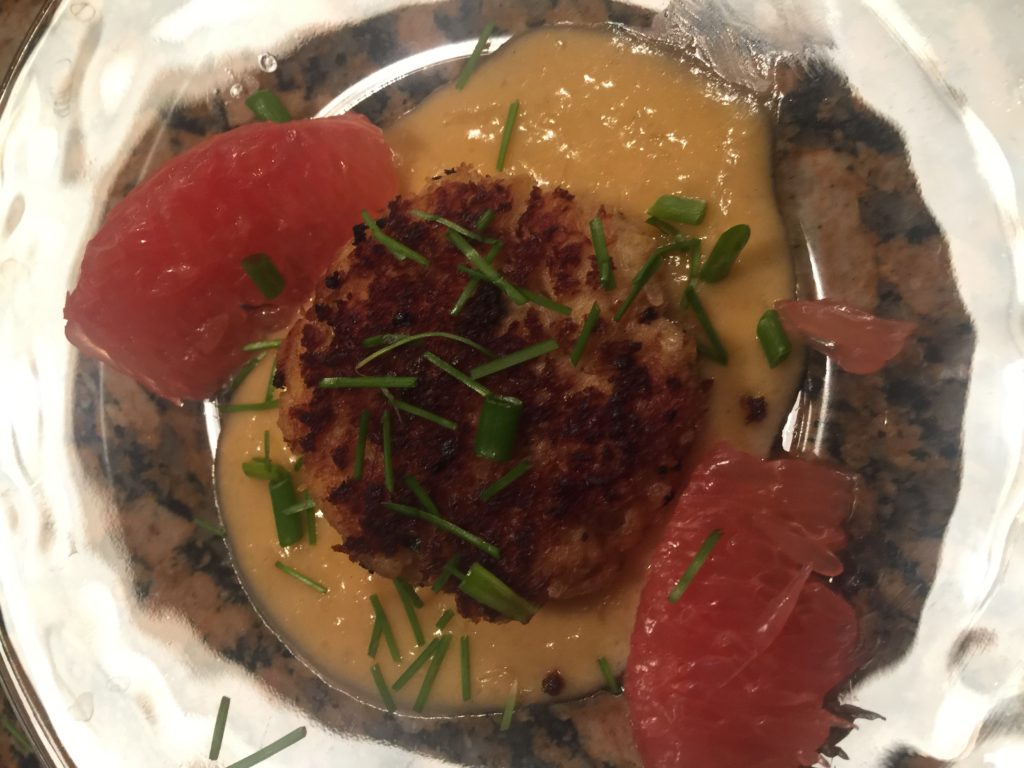
2016 Patz & Hall Chardonnay, Sonoma Coast
Patz & Hall
Donald Patz and James Hall met in the 1980s while working at Flora Springs Winery. Donald was a national sales manager and James was an assistant winemaker. They became close friends and decided that they wanted to make their own wine from elite small vineyards. In 1988 they teamed up with their wives and business partners, Heather Patz and Anne Moses, put up $5000, and Patz & Hall was born. Now Patz & Hall is one of California’s most highly regarded wineries with a really good portfolio of single-vineyard wines. They specialize in Chardonnay and Pinot Noir.
By the late 1990s, they were able to focus 100% of their attention on making and selling their wines. Since they had no vineyards, no tasting room, no office and no employees, they decided to move to the next level and opened a tasting room and office in a warehouse in Napa which is where we first found them in 2007. They bought quality grapes from Hyde, Hudson, Dutton Ranch, Zio Tony Ranch, Gap’s Crown, Alder Springs and Pisoni. Their wines frequently earn outstanding ratings. About that time we also met Donald Patz on one of his marketing tours and enjoyed a tasting with him of all their wines at one of our favorite local restaurants, Angelina’s Ristorante in Bonita Springs, Florida.
With the business going well, they moved to a new facility in Sonoma with a visitor’s center and winemaking facility designed by Hall. In fact business was going so well that Patz & Hall soon reached an agreement with Ste. Michelle Wine Estates to purchase the company. Ste. Michelle wanted to expand into Sonoma, and the partners agreed to stay on after the sale, selling the brand, inventory and winery equipment to the new owners. The two families still continue making wine together after 30 plus years. We can verify that Patz & Hall is still making outstanding wines.
2016 Patz & Hall Chardonnay, Sonoma Coast AVA
Patz & Hall Sonoma Coast Chardonnay is one of their entry-level Chardonnays made from a diverse blend of small family owned vineyards on the coastal side of Sonoma County. Sonoma Coast is the coolest of the regions. This one was aged on lees in 32% new Burgundy barrels with 100% malolactic fermentation in the barrel. The winemaker said it should have aromas and flavors of dried orange peel, green apples, spicy pears, lime zest plus notes of roasted almonds, yeast and toffee. We were also ready to enjoy the long layered finish. The alcohol level is 14.2%. It received 90-93 points as have the previous vintages. Since most of their wines are from single vineyards, we were really anxious to give this non-single vineyard offering a try and it was a crowd favorite of the night, I do believe, meeting all of our expectations. We purchased this bottle from wine.com for $39.
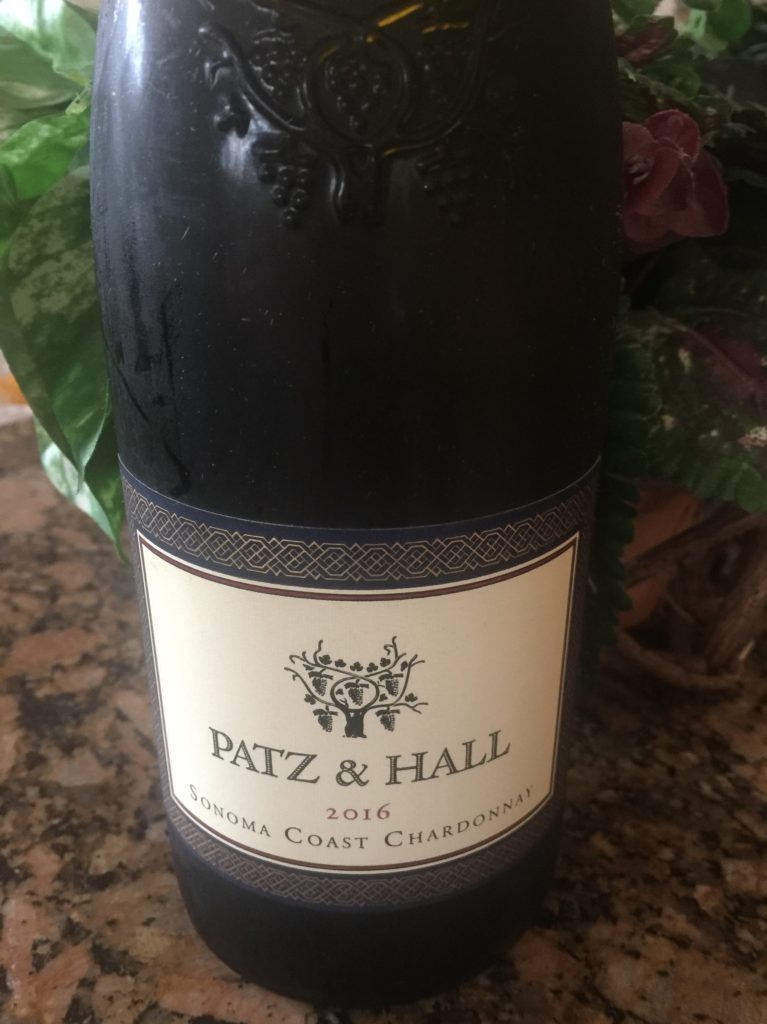
2016 Rodney Strong Chalk Hill Chardonnay, Chalk Hill
Rodney Strong Vineyards
The story of Rodney Strong Vineyards began over 55 years ago when Rod Strong, a ballet dancer, retired in Sonoma County to pursue his dream of winemaking. He started a winery and renamed it Rodney Strong Vineyards in 1980. The Klein family purchased it in 1989. Planting new rootstocks, new trellising and new varieties enabled them to focus on appellation-driven grapes such as Pinot Noir and Chardonnay from Sonoma cool areas, and Cabernet Sauvignon and Zinfandel from Alexander Valley – all Sonoma County. Rod Strong was the first to plant Chardonnay in what is now the Chalk Hill AVA. Way back in 1965 he recognized the uniqueness of this region from the rest of Russian River Valley because of that volcanic chalky white ash soil which gives the wine its subtle mineral characteristics.
Rodney Strong Vineyards was the 13th winery bonded in the newly discovered Sonoma County wine industry. Through the years Rodney Strong has earned their well-deserved reputation for single vineyard and reserve wines including best-in-class Sonoma County varietal wines, and Chalk Hill Vineyard is certainly no exception.
2016 Rodney Strong Estate Vineyards Chardonnay, Chalk Hill AVA
Rodney Strong’s Chalk Hill Chardonnay was made from 100% Chardonnay grapes grown in their Chalk Hill Vineyard. It was 97% barrel fermented in 100% French oak for 12 months. The lees were regularly stirred in the barrel to give a full and creamy texture on the palate. We got those flavors of pear, vanilla, Meyer lemon and a bit of minerality on the finish. And yes it was a perfect pairing with fresh crab! Alcohol level is 14.5% and it received several 90 point ratings. This was a $22 bottle of wine that we even got on sale for $17 from our internet go-to wine company and a Wine Star Awardee in their own right, wine.com. Chalk Hill is also further inland and warmer than Sonoma Coast but has the white volcanic ash hillsides. We were anxious to taste these two Chardonnays side by side but I think it may have been a well deserved tie between the two of them.
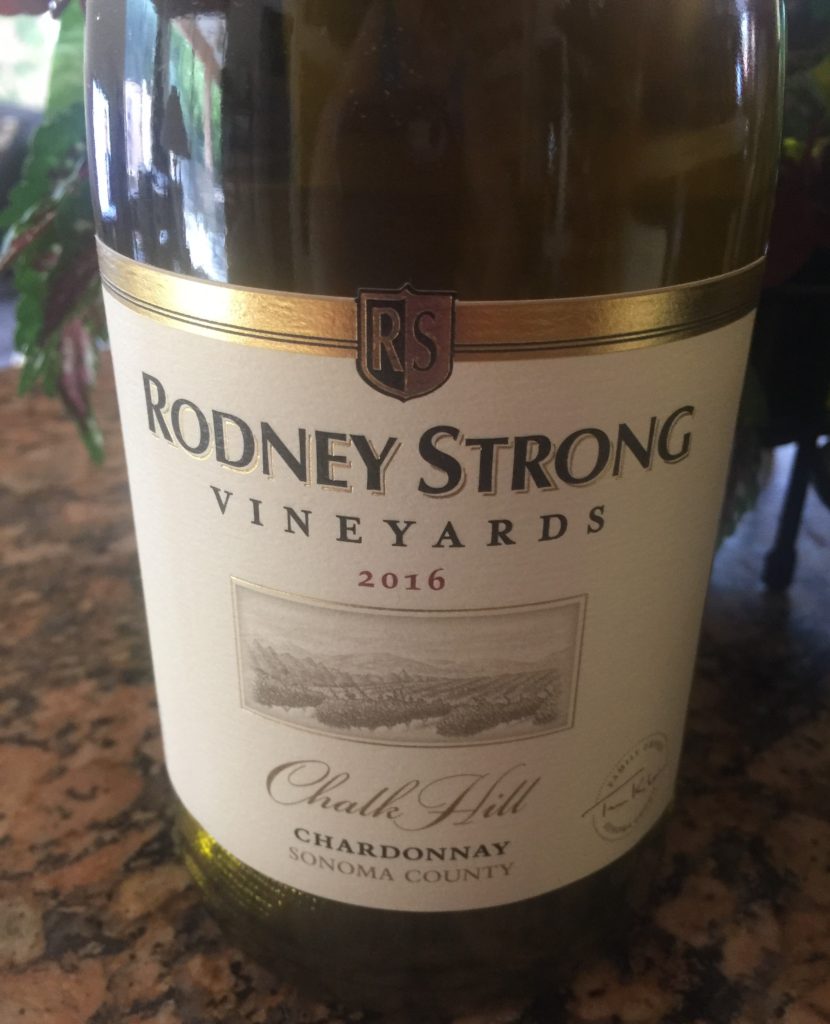
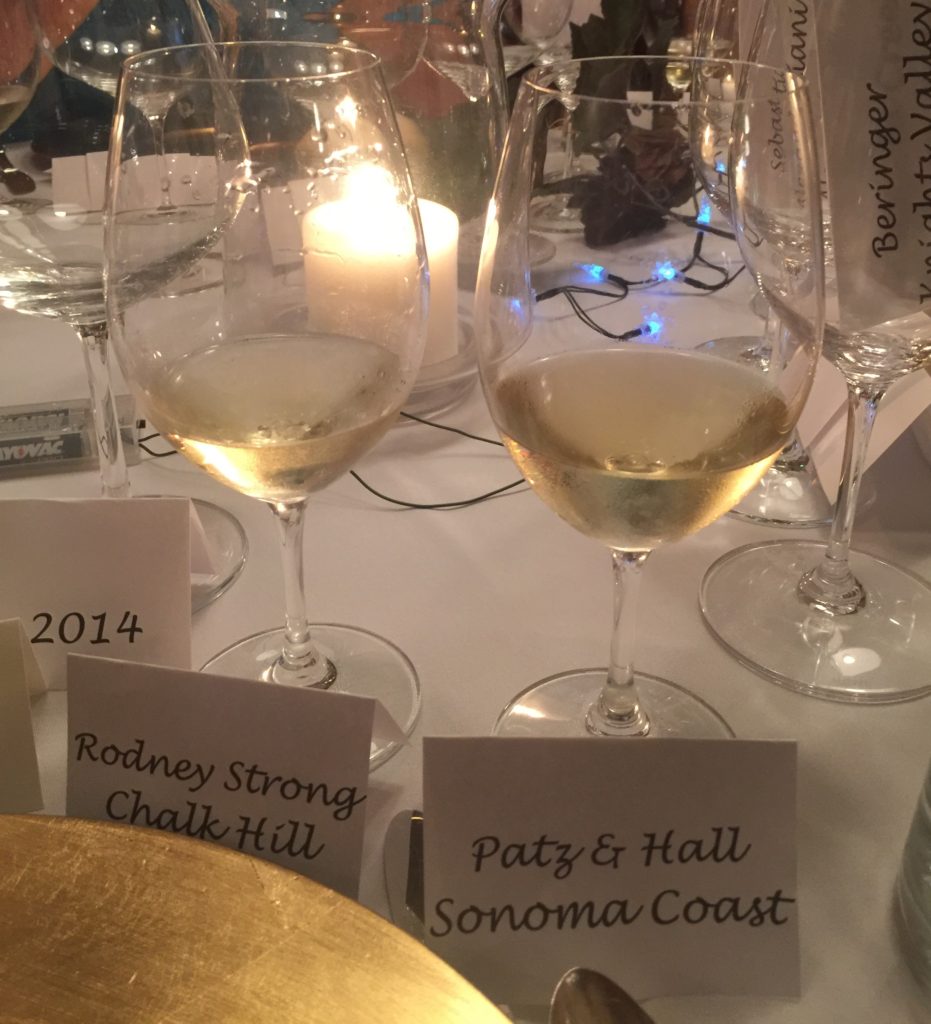
Second Course: A Pinot Noir Vertical of Small Vines Wines
Russian River Valley AVA
Bacon Wrapped Scallops with Creamy Mascarpone Polenta and Roasted Red Pepper Salad
Paul and Kathryn Sloan post recipes on their website that are outstanding suggestions for pairing up with their Green Valley/Russian River Valley wines. As soon as I saw this recipe, I knew looking further was not an option. And by the way, it’s a recipe from Chef/Owner Charlie Palmer and his Dry Creek Kitchen restaurant in Healdsburg. We had the pleasure of dining there for my birthday on one of our visits to Sonoma County.
The scallops were wrapped in bacon, seasoned and pan seared until golden. I chose to par-cook the bacon before wrapping as I know it takes but just a few minutes to cook these beautiful scallops, and I prefer my bacon well cooked. Be sure to use the biggest sea scallops you can get. They are always worth it! If you are serving “small plates” as we usually do, you can then plan on serving one or two depending on the size. I cooked the instant polenta in chicken stock as called for in the recipe (even though I heard that many polenta purists would never ever think of using the instant kind!), seasoned with salt and the last of my piment d’Espelette, whisked in the mascarpone, and it was delicious. I read somewhere about cooking the polenta in advance and keeping warm in a slow cooker, and because I have so many pans and skillets of food going on at the last minute for a wine dinner, I am always looking for a way to hold food that will still maintain quality and not need last minute cooking. Amazingly the polenta just required some vigorous whisking before plating to bring it back to it’s perfect self, and it was just as good as new! Always good to have a few cooking hacks up your sleeve. The roasted red peppers were finished off in garlic, EVOO and white wine in the scallop pan. Add the fresh basil and this wonderful dish is ready for plating. And the really good news? Paul even recommended we serve this dish with their Small Vines Wines Estate Cuvee Russian River Valley Pinot Noir. Since there was a vertical of it for at least three years in our collection, this was a food and wine lover dream pairing.
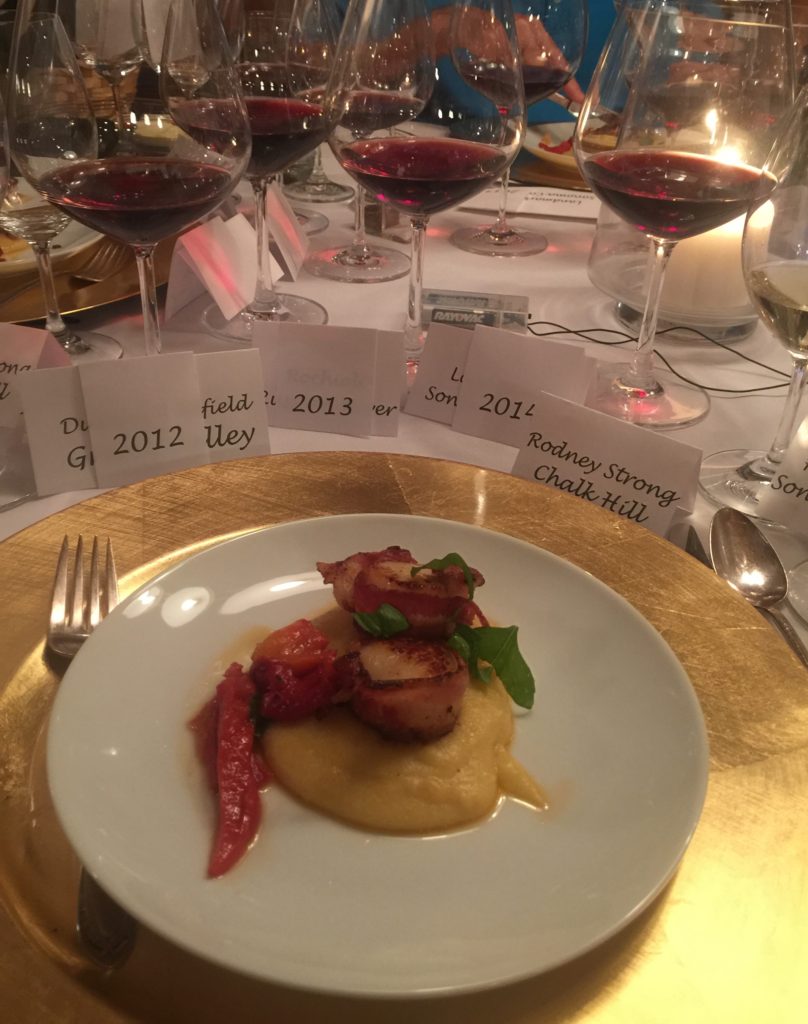
2012 Small Vines Wines Estate Cuvee
2013 Small Vines Wines Estate Cuvee
2014 Small Vines Wines Estate Cuvee
Small Vines Wines
Small Vines Wines was founded in 2005 by Paul and Kathryn Sloan with their first vintage of Pinot Noir. They may grow small vines but they make some really big Grand Cru-quality Pinot Noirs! And Chardonnays. Put together that dusty Goldridge soil west of Sebastopol in Green Valley with Paul’s Burgundian style of organic farming and you have a Pinot marriage made in heaven. He started out running a vineyard management business which he still operates today. After learning how vineyards are farmed in the Côte de Beaune and Côte de Nuits and the concentrated flavorful fruit that they produce, Paul opted to plant his vineyards with narrow rows of only four feet across which even called for purchasing special tractors from France small enough to fit between the rows. The vines are farmed so individually that Paul says they touch each vine independently over 28 times during the growing season. The yield of each vine is also small – about 1-2 pounds of fruit compared to an average yield of ten times more in California. At harvest time, Pinot Noir grapes are handpicked in the cold of night, hand sorted twice, and whole-clustered during fermentation. They use French oak barrels from Burgundy that have been aged a minimum of 3 years. The wine usually spends about 14 months in the barrel and is bottled unfined unfiltered.
In addition to the 7 acres of vineyards that they lease and manage, they purchased the Barlow Homestead and now have their own 8 acres of vineyard. The Barlows were prominent apple and berry farmers in West Sonoma County and the historic farmhouse that they now live in on the property dates back to 1897. Look for Small Vines Wines Pinot Noir and Chardonnay from their vineyard (TBH) The Barlow Homestead in Green Valley, and MK Vineyards Sonoma Coast Pinot Noir, Baranoff Vineyards Russian River Valley Pinot Noir, Estate Cuvee Russian River Valley Pinot Noir, and Sonoma Coast Pinot Noir. You won’t find much of it – they just make around 42,000 bottles a year. Plus 75% is sold direct to the consumer.
We experienced a wonderful tasting experience with Paul Sloan on his Barlow estate in 2007 before they were even able to move into the farmhouse. Paul poured a taste of every one of his labels for the two of us, paired them up with some appetizers and spent several hours telling us about his wines and his hopes for the future. Those are the kind of experiences that this winelover will forever remember!
2012, 2013 and 2014 Small Vines Wines Estate Cuvee Pinot Noir, Russian River Valley AVA
Green Valley AVA is actually within the Russian River Valley AVA. However, we tasted a 3 year vertical made by Paul and Small Vines Wines from vineyard estates that he manages in Russian River Valley, but not exclusively Green Valley. The vineyards were farmed organically by Small Vines Viticulture adhering to Grand Cru standards. The soils were red sandy clay loam to dark gray Goldridge fine sandy loam. All three vintages spent 15 months on fine lees and were bottled unfined and unfiltered. Oak was 31 – 37.5% new French. There were 390 cases made (2012), 524 (2013) and 360 (2014). All three vintages gave us dark cherry and plum notes with earthy forest floor and earthy mushrooms with soft and silky texture. According to Kathryn, the 2012 vintage was more full and generous, the 2013 very cool, elegant, fresh and bright and the 14 incredibly well balanced with nice concentration. I didn’t make notes on our guests comments, but the general consensus seemed to be that we greatly enjoyed every one of those wines! Small Vines Wines are always highly acclaimed but here again don’t expect to see them on a local wine store shelf. I purchased these wines direct from the winery for $50 to $65 a bottle.

Third Course: A Horizontal of 2014 Pinot Noirs
A trio of Sonoma County AVAs
Terrine of Grilled Eggplant, Red Peppers and Goat Cheese with Parsley Sauce
My friend Anita was inspired to make this dish after reading about Cafe LoLo, a French Mediterranean restaurant in Santa Rosa, California that unfortunately is now closed. The recipe itself is from one of those old Gourmet Magazines that are irreplaceable! You can do an internet search and find it in their July 1993 issue.
Anita broiled eggplant slices and then layered them in loaf pans with black olive tapenade, roasted red bell peppers and goat cheese, wrapped well in plastic and refrigerated overnight resulting in these gorgeous colorful slices of vegetables. A puree of fresh parsley, garlic, balsamic vinegar and EVOO made the delicious parsley sauce that was served with the terrine. This dish was a great example of Sonoma County local fresh produce and cheese making. Great choice, Anita! And a really good option if you are transporting a dish for service somewhere else.
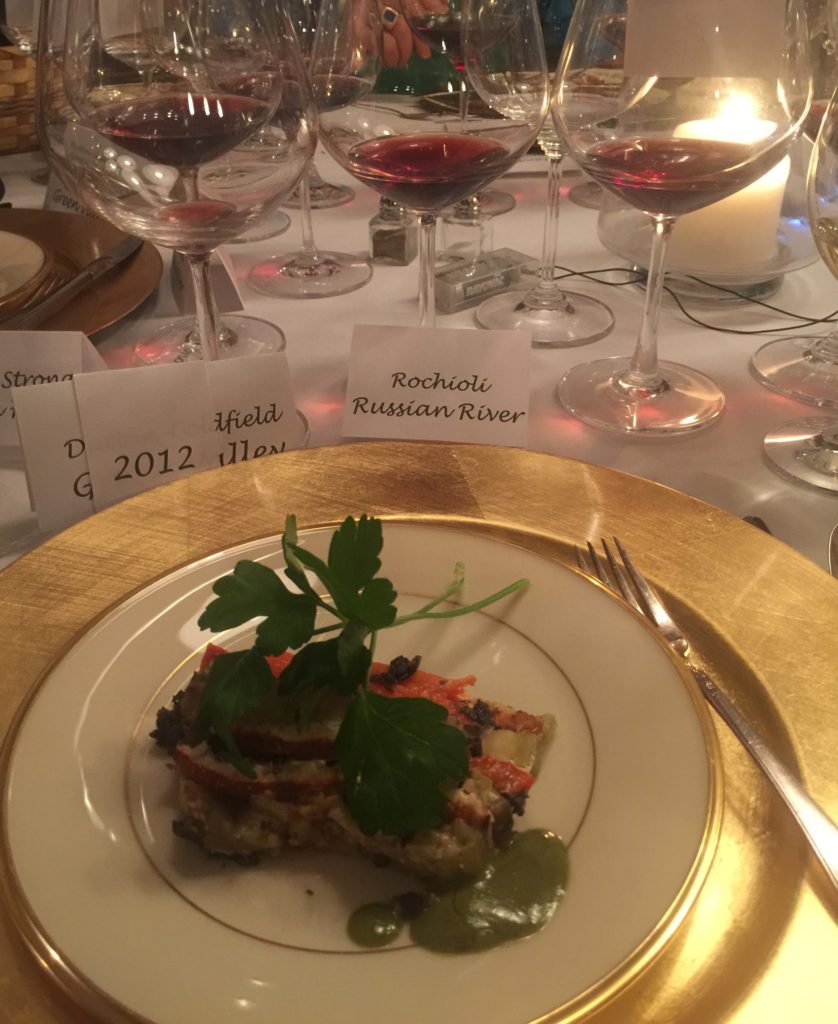
What do you pair with a gorgeous chilled vegetable terrine? Why a horizontal of Pinot Noirs from the same area, of course! After all as the saying goes……….what grows together goes together. Three Pinots were selected from the same vintage but from three different AVAs – the cool coastal Sonoma Coast, the famous Russian River Valley which is highly praised for Pinot Noirs and the Green Valley, a sub-region within Russian River Valley and famous for their Goldridge soil.
2014 Landmark “Grand Detour” Pinot Noir, Sonoma Coast
Landmark Vineyards
Landmark Vineyards were founded in 1974 by a group of people including Damaris Deere Ford, the great-great-granddaughter of John Deere, who invented the steel plow. By 1989 Damaris was the sole owner and moved Landmark to its present location in Kenwood, Sonoma Valley. In 1993 Landmark hired Helen Turley to make some world-class Chardonnay. Grand Detour was their first Pinot Noir release in 1995. Grand Detour just happens to be the name of the village in Illinois where John Deere set up his blacksmith shop. Since then their Overlook Chardonnay has been on Wine Spectator’s Top 100 list eight times. Landmark calls the Sonoma Valley home but sources grapes from vineyards in Sonoma (including Sonoma Coast), Monterey and Santa Barbara Counties. You can visit them in their tasting room outside Healdsburg in the Hop Kiln winery (bought by Landmark in 2016) or at their estate in Kenwood, which is where we enjoyed all of their wines.
2014 Landmark Grand Detour Pinot Noir, Sonoma Coast AVA
The 2014 Grand Detour Pinot Noir was sourced from several vineyards in Sonoma Coast and was smooth and velvety with some anise, black tea, rose petals and cherry pie as promised by the winemaker. It was worthy of those 90 points from Wine Enthusiast plus a Gold Medal at the San Francisco Chronicle Wine Competition and a Silver at the Los Angeles International Wine Competition. It retailed for about $35 a bottle.
2014 Rochioli “Sweetwater Vineyard” Pinot Noir, Russian River Valley
J. Rochioli
This is yet another wonderful story of Italian immigration to America when Joe Rocchioli Sr. moved here in 1911 from a small village just outside of Lucca. They made their way across the United States and settled in Northern California. The senior Rocchiolis worked on a farm in Russian River Valley eventually moving to 125 acres called Fenton Acres, which just happens to be where Rochioli Vineyards are today. Back in those days they grew hops, string beans and prunes but they also planted blending grapes like French Colombard, Early Burgundy and Napa Gamay to use for “jug wine”. Being good entrepreneurs, by the mid-1950s they bought the property. They planted Cabernet Sauvignon and Sauvignon Blanc in 1959 but it didn’t grow well and in 1968, the first Pinot Noir was planted using fine Pinot clones from France, a pioneer idea at the time. They learned that the Russian River Valley climate made Pinot Noir and Chardonnay excellent choices. They changed the name from Fenton Acres to Rochioli and released their first estate wine in 1987. Amazingly to the Rocchiolis the 1985 Rochioli Vineyards Pinot Noir made by Williams Selyem was named “The Best Pinot Noir in America” by Wine Spectator! The rest was history. Now they have 140 acres in production in Russian River Valley, focus on single vineyards and their wines are all top rated. I would find it hard to believe that anyone who enjoys Pinot Noir from Sonoma County does NOT know about the famous Rochioli Pinots. Wine is generally made available on a limited basis to customers on “The List”, and once you get on it, I advise you not to jump ship!
2014 Rochioli Sweetwater Vineyard Pinot Noir, Russian River Valley AVA
The 2014 Sweetwater was made from three clones – Pommard, Dijon 115 and the Rochioli Selection. Only 424 cases of this wine were made. Robert Parker said it should drink well for at least a decade. WS gave it 91 points and WA 94! I purchased mine from the winery in 2016 for $79 a bottle and see collector’s offering theirs online for $115. We were promised cherry, berry and plum flavors with smoky, toasty oak and that is what we got. I still have yet to taste a Rochioli Pinot Noir that was not an excellent choice!
2014 Dutton-Goldfield “Fox Den Vineyard” Pinot Noir, Green Valley
Dutton-Goldfield
Dutton Ranch and the Dutton-Goldfield Winery and tasting room are in Green Valley, an AVA at the southwestern corner of the Russian River Valley AVA that we have already mentioned is known for Goldridge soil. Dutton-Goldfield began back in 1998 when Steve Dutton, the grapegrower, and Dan Goldfield, the winemaker, decided to team up to make some wines that show off the distinct differences of their vineyards in this cool coastal region. They knew what they personally liked to drink and wanted the rest of us winelovers to share the same great experiences. They specialize in Pinot Noir and Chardonnay but also produce small amounts of Syrah, Zinfandel, Pinot Blanc, Riesling and Gewurztraminer. Steve’s Dutton Ranch Vineyard is made up of over 80 separate small vineyards. They also source grapes from single vineyards in Marin County, Sonoma Coast and Anderson Valley.
2014 Dutton-Goldfield Fox Den Vineyard Pinot Noir, Green Valley AVA
Dan and Steve planted this 8 acre vineyard together in 2002, and Dan has been making wine from it since 2004. It is located on top of Stoetz Ridge on the western edge of the appellation and is just a tiny bit warmer on the hilltop than the bottom of the valley, but it still has that low nitrogen sandy soil that helps vines grow and fruit ripen slowly. The wine from this vineyard is usually quite silky with bright raspberry fruit and natural acidity just like a perfect Green Valley Pinot Noir. This bottle of 2014 Fox Den went through open top fermentation with cold soak and punch down, then was aged 17 months in 55% new French oak barrels. Alcohol level is 13.8% and according to the winemaker should present with cherry, strawberry and raspberry aromas, rose petals and rhubarb pie! Then there should be some Bing cherries and Chambord with a smooth texture and creamy strawberry shortcake on the finish. OK – sounds like dessert and we got it! WE rated it 94 points and RP gave it 91. This was my first bottle of Dutton-Goldfield and I thought it was exceptional as did our guests. Just 767 cases were produced. We recently purchased this bottle from wine.com for about $70. While I will always love my Rochioli Pinot, this Fox Den Vineyard was my personal horizontal winner.
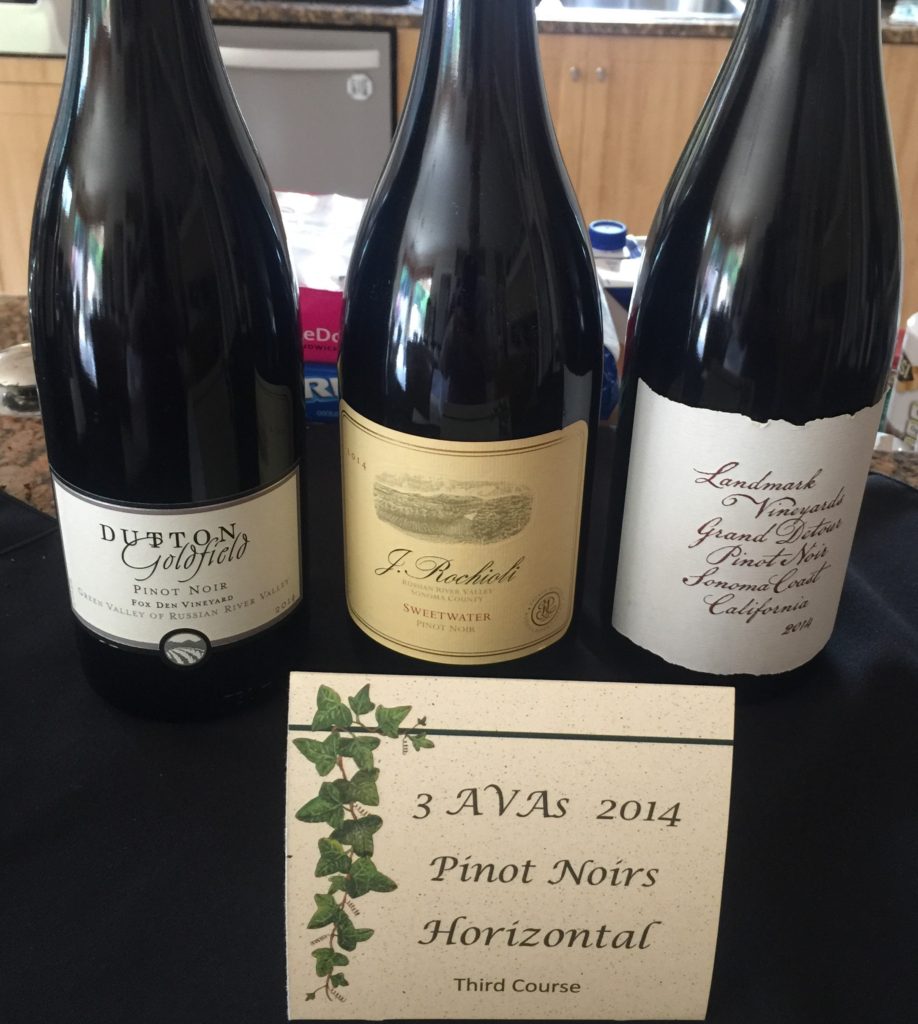
Fourth Course:
Cabernet Sauvignon from Two Valleys
Braised Boneless Beef Short Ribs in a Hoisin Soy Sauce with Basmati Rice, Sesame Seeds, Scallions and Cilantro
When searching for recipes from Sonoma County wineries or restaurants, I discovered that the Sonoma County “WINEROAD” website not only gives loads of information about Sonoma County wineries, but also events and recipes from their “WINE & FOOD AFFAIR RECIPES” webpages. You can search for recipes by winery, category, main ingredient or wine pairing. While looking for a beef recipe that would pair well with the Alexander Valley Cabs and look good as a “small plate”, I came across a recipe for braised beef short ribs published by Soda Rock Winery that was supposed to pair well with just that wine. Since Soda Rock Winery had great historical significance in Alexander Valley and most of it was lost to the Kincade fire, I knew I had found my “perfect” food to represent this AVA. The dish had an Oriental flair as the meat was cooked in a sauce of ginger, hoisin, soy sauce, honey and Cab plus a host of other wonderful seasonings; then served with basmati rice and garnished with chopped fresh scallions, cilantro and sesame seeds. We chose to use boneless short ribs for our dish for ease in serving as a small plate, cooked it all a day in advance, then cut the meat into bite-size pieces ( I did not want it shredded!), reheated it in that wonderful cooked down and strained sauce. What a delicious dish and the pairing was superb! You can find the recipe on the Wine & Food Affair site under Soda Rock Winery.
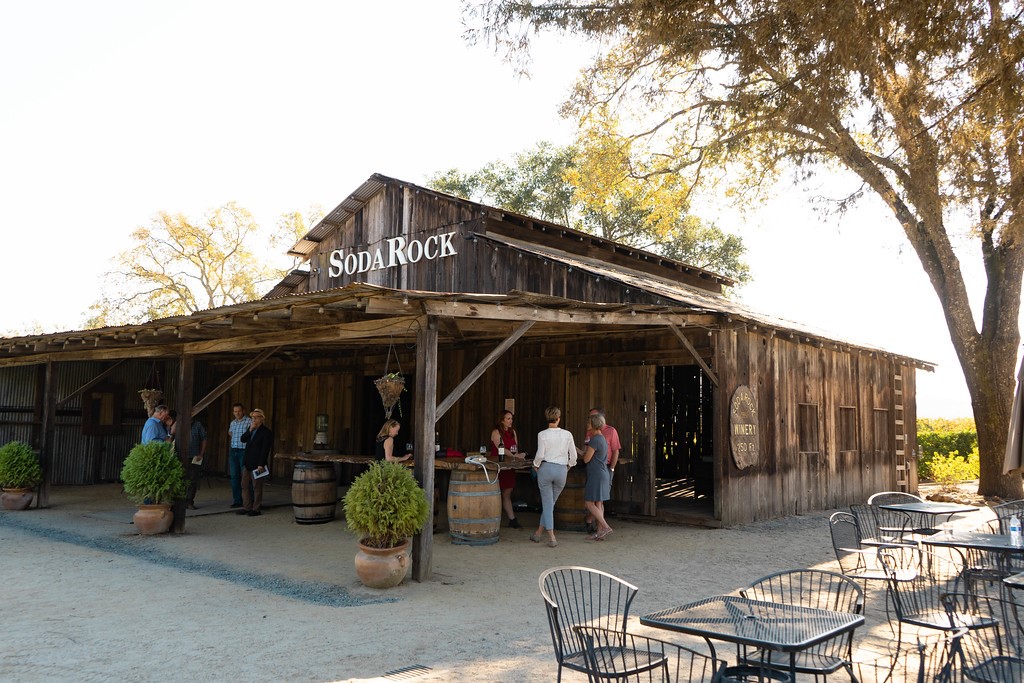
2015 Sebastiani Cabernet Sauvignon, Alexander Valley
Sebastiani Vineyards & Winery
The story of Sebastiani begins with Samuele Sebastiani’s emigration from Tuscany in 1895. He worked as a stonemason, saved his money to buy land in Sonoma County and started Sebastiani Vineyards & Winery in 1904. His was the only winery in Sonoma County to continue operating during the Prohibition. Samuele made sure his neighbors had work during the Prohibition and Depression by building projects around the plaza and the church or canning fruit. His son August carried on this philosophy by having Sebastiani barrels hand-carved by craftsmen of Sonoma. You can still see them at the winery located in downtown Sonoma. The “Original vineyard block” was planted primarily in Cabernet Sauvignon in 1961. Sebastiani created one of Sonoma County’s first varietal Cabernet Sauvignons. They continue to make varietal Cabs from Alexander Valley and North Coast plus that original vineyard now known as Cherryblock.
Bill Foley purchased Sebastiani in 2008 and continues to honor their past traditions while taking it into the future. They continue to make consistent highly acclaimed wines. The first thing he did was to cut down production allowing winemaking efforts to focus on exceptional vineyard sites and eliminating lesser quality wines. They have replanted the estate vineyards, focus on vine-by-vine farming and use a more natural approach in the cellar. Sebastiani wines are now more concentrated and complex in all tiers. Sebastiani has been a long-term practitioner of sustainable farming working with the California Sustainable Winegrowing Alliance to continue their responsibility to protect the land with an emphasis on single-vineyard and sub-appellation wines.
2015 Sebastiani Alexander Valley Cabernet Sauvignon
Alexander Valley is a warm inland valley with perfect weather for making great Cabernets. This 2015 Alexander Valley is a blend of 95% Cabernet Sauvignon Blanc and 5% Merlot. It has been receiving 91 – 92 point ratings for several years now. According to the winemaker’s notes, it is rich in cassis, vanilla and cocoa powder with a focus on blackberry fruit flavors in an elegant style. We expected it to be full-bodied with a long finish and it did not disappoint. This great little bottle of Alexander Valley Cab cost just $27 and was delivered right to our door from wine.com.
2015 Beringer Cabernet Sauvignon Reserve, Knights Valley
Beringer
Beringer is one of California’s oldest continually operating wineries with history that dates back to 1868. That is when Jacob Beringer left his home in Mainz, Germany and sailed to New York to find new opportunities. He made his way to Napa Valley after hearing that the rocky hillside soil and fertile valley floors of Napa Valley were similar to German vineyards, and he and his brother Frederick bought 215 acres of land there in 1875. Their winery was one of the first in Napa Valley. We won’t go into detail here since this was a Sonoma County wine dinner, but if you have never visited the Beringer estate in Napa Valley, you are missing out on a lot of wonderful history. It is an excellent experience that will not be forgotten!
Beringer has owned and been farming vineyards in Knights Valley since the mid-1960s, and their vineyard is just 17 miles north of the Beringer winery. Beringer first used a Knights Valley designation on the label in 1974 and was instrumental in getting approval for the AVA in 1983. They also grow Sauvignon Blanc grapes there. Knights Valley is the warmest of all the AVAs and has plenty of volcanic soil. The ancient volcano and Sonoma County’s highest mountain, Mount Saint Helena, looks down over the valley. All this gives the Cabs their full-bodied ripe flavors.
2015 Beringer Cabernet Sauvignon Reserve Knights Valley AVA
Beringer Knights Valley Cabernets are always highly rated and the 2015 received scores between 92 and 95 points. It was aged in small French Nevers oak barrels (56% new) for 19 months. Winemaker notes tell us it should have aromas and flavors of dark fruits like blackberry, currants, smoked meats and baking spices with menthol, cedar cigar box and pipe tobacco. The finish should be long with a dense texture. It’s 15% alcohol and made of 92% Cabernet Sauvignon, 6% Malbec and 2% Petit Verdot; 6,030 cases were made. It definitely held true to the winemaker notes and it was a perfect pairing with the short ribs in a hoisin soy sauce. I think this pairing surprised a number of people, but if Soda Rock Winery thought it a good pairing for Cab, that was good enough for me! We bought this bottle from wine.com for $58, a most reasonable price for the high scores, proving once again the great value for price from Sonoma County wines.
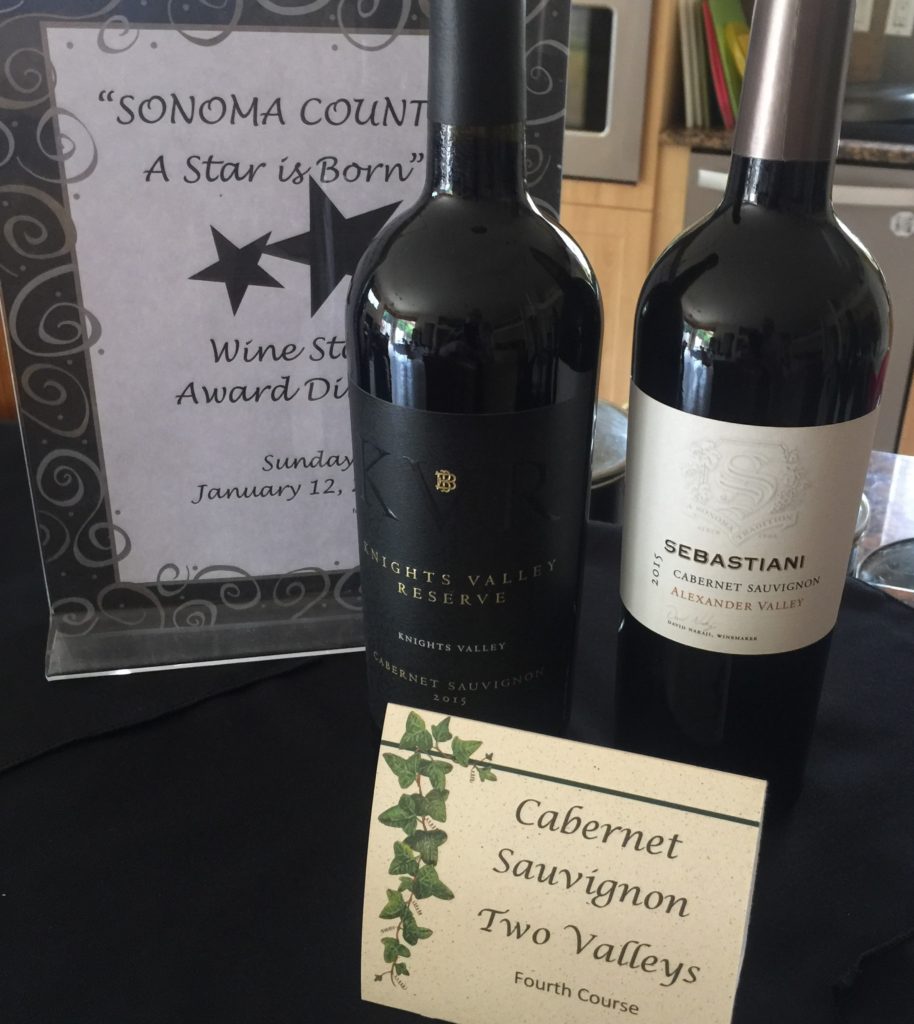
Fifth Course:
Cabernet Sauvignon from Two Mountains
Duck Leg and Mushroom Ragu on Cavatelli
Our winelover friend Jeff is quite an accomplished home chef. He prepares special dinners paired with great quality wines for friends and family almost every week without even blinking! We gave Jeff the challenge of pairing our Cabernets from two mountains with an outstanding small plate for the fifth course, and he immediately came up with this slow cooked duck leg and mushroom Bolognese style sauce served over cavatelli pasta. And then he made his own cavatelli. Wow!!!! It was indeed a perfect pairing. Even better………..he brings his own pots and pans! You can cook for us anytime, Jeff.
2014 Laurel Glen Estate Cabernet Sauvignon, Sonoma Mountain
Laurel Glen Vineyards
The Sonoma Mountain AVA is centered in the Sonoma Mountains in the northwest area of the Sonoma Valley AVA which almost surrounds it between the towns of Sonoma and Santa Rosa. The vineyards bake in the sun during the day and cool down at night in the mountain air. It is able to make a wide range of varietals in addition to great Cabs.
A notable producer of Cabernet Sauvignon on Sonoma Mountain is Laurel Glen Vineyards. Laurel Glen started out in 1977 as three acres of Cabernet Sauvignon vines on top of the mountain ranging from 850 to 1000 feet high. The first wine labeled Laurel Glen was produced in 1981. There were 14 acres under vine when the property was sold in 2011. There are nine separate blocks, all planted in Cabernet Sauvignon, made up of red sandy soil of volcanic origin, and the property looks down on the town of Glen Ellen. All of the viticulture is now strictly organic, and in 2014 the vineyard became CCOF organic certified. Their goal is to enhance the soil quality, minimize use of irrigation water and to preserve the wild spaces surrounding the property. They plant cover crops such as sweet pea, daikon radish and mustard to minimize soil erosion and control weeds. No synthetic pesticides or herbicides are used and their farming methods to minimize runoff into streams help to sustain the salmon and steelhead population. The winemaking philosophy is minimal handling, using gravity flow when possible and keeping all lots separate. The wines are aged in Taransaud French oak and Canton American oak barrels – the percentage of each and length of aging depending upon the wine lot.
2014 Laurel Glen Vineyard Estate Cabernet Sauvignon, Sonoma Mountain AVA
The 2014 Laurel Glen Vineyard Estate wine was made after the ending of a 4 year drought in 2016. 2014 was one of those years that does not happen very often in which quality and quantity of the fruit were both excellent. The fruit was high quality despite the drought and a 6.0 magnitude earthquake in August! There were 1,220 cases bottled in July 2016. Tasting notes from the winemaker Randall Watkins said “Beautiful fragrance of sweet boysenberry and dark raspberry fruit, mineral and smoke. Hints of espresso, charred oak and baking spices.” It was impressive on the long finish, with elegance and finesse amid firm mountain tannins. It received scores between 92-95 points as did the previous vintages. This bottle was recently purchased from wine.com for $75.
2014 Amapola Creek Estate Cabernet Sauvignon, Moon Mountain
Amapola Creek
Moon Mountain was the 16th approved AVA and sits high above the eastside of Sonoma Valley in the Mayacamas Mountains. These are mountain wines at their finest made on elevations from 600-2600 feet in red volcanic and ash soils.
The story of Amapola Creek by Richard Arrowood has somewhat of a bittersweet ending. The Amapola Creek winery itself was completed on Moon Mountain in October 2007 just in time for crush. It’s a very small ultra-premium facility with state-of-the-art equipment. Richard Arrowood is a legendary vintner who made wine in Sonoma County for more than 50 years. He made the wines for Chateau St. Jean from 1974 until 1990, and then founded his own Arrowood Vineyard & Winery with the 1985 vintage. He sold Arrowood Winery to Robert Mondavi in 2000 who then later sold it to Jackson Family Wines in 2006. He left Arrowood as winemaster back in 2010 to devote himself full-time to making the great wines of his estate winery on Moon Mountain. The Amapola ranch has about 100 acres along the western slope of the Mayacamas Mountains. The red, iron-oxide soil has been producing high quality wines for over a century. Amapola is right next door to the very famous Monte Rosso Vineyard. Their Chardonnays, Cabernet Sauvignons, and Zinfandels have always received high ratings from various wine critics. There are roughly 20 acres of organic vineyards currently producing over 5,000 cases annually.
The bittersweet ending to this story is that as of January 10, 2020, Amapola is owned by B. Wise Vineyards of Sonoma Valley. Brian Wise, Dick Arrowood’s neighbor, purchased it from Dick who is retiring after 54 years of work. Congratulations Dick on your retirement, and thanks for a job well done!
2014 Amapola Creek Estate Cabernet Sauvignon Moon Mountain AVA
The Cabernets of Amapola Creek are favorites of Robert Parker who consistently gave them ratings between 94-96. The 2014 is 94 points and is a blend of 93% Cabernet Sauvignon and 7% Petit Verdot. According to our winemaker, there should be blackberry and red plum on the nose followed by blackcurrant and pomegranate with subtle notes of oak and toasted vanilla. We got all of that plus the anise and a finish of chocolate, blueberry preserves and aged cedar. We were ecstatic to drink this Moon Mountain Cabernet and wish Dick Arrowood well in his retirement! We bought this bottle from wine.com for $65. Sonoma County mountain Cabs are not to be taken lightly!
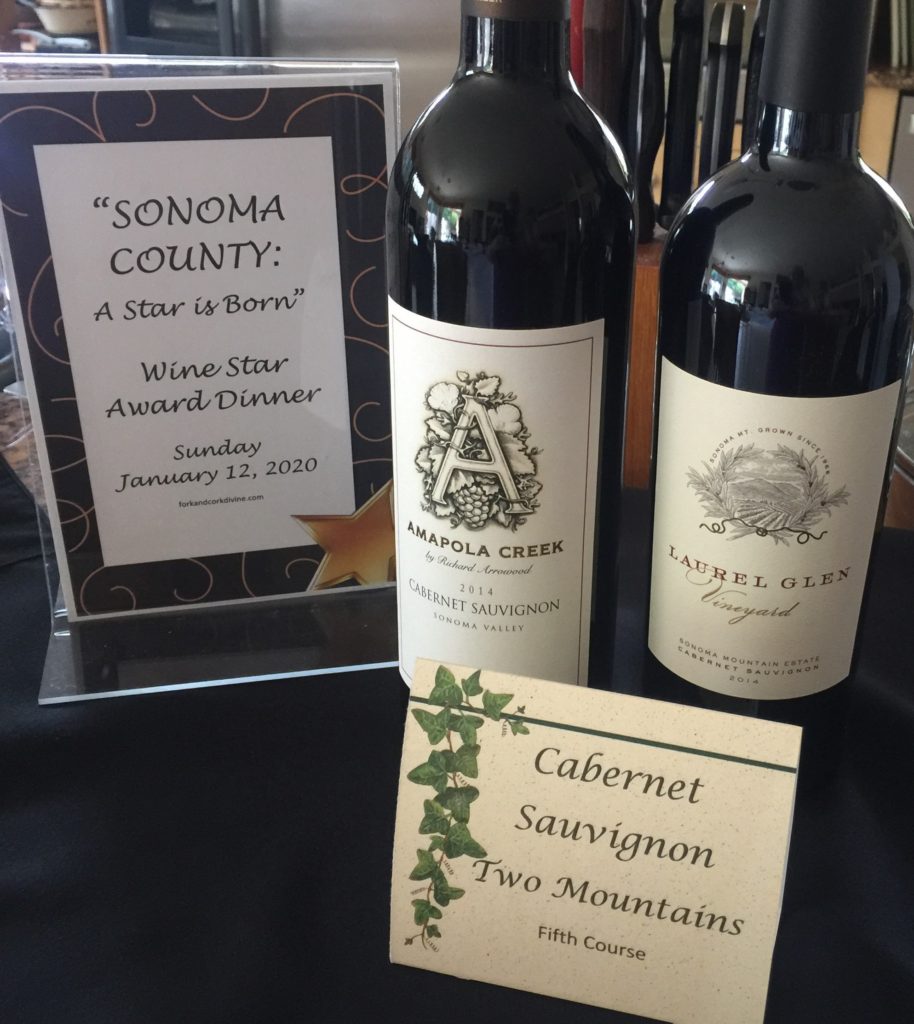
Sweet Endings:
A Vertical of A. Rafanelli Zinfandel
Dry Creek Valley AVA
It was mandatory for me to serve A. Rafanelli Zinfandel at a Sonoma County wine dinner! There were a number of years in our collection, so another three year vertical seemed appropriate. What goes well with Rafanelli Zin? Well, lots of things but chocolate really does it justice. I always end our wine dinners on a sweet note, and challenged our guest Mariann to make this chocolate cherry cake that was featured on the wineroad website by another Dry Creek Valley winery to be paired with Zinfandel. It was really a winner. It’s a very dense cake made from cocoa powder, chocolate chips and canned cherries. The chocolate icing was almost like a ganache. Just a few bites of this cake with a taste of each of those Rafanelli vintages, and you would think you were in wine and foodie paradise!
I also supplemented that delicious cake with some homemade biscotti, yet another recipe from the wineroad website, an assortment of cheeses that pair well with Zinfandel, fresh blackberries and of course – a selection of dark chocolate candies! Something for everyone’s sweet tooth and all three of those Zins.
Chocolate Iced Chocolate Cherry Cake
Biscotti da Insuppare nel Vino (“to dip in wine”)
Cheese Plate:
Brie, Smoked Beechwood Cheddar, 1000 Day Aged Gouda and Blue
Dark Chocolates
Fresh Blackberries
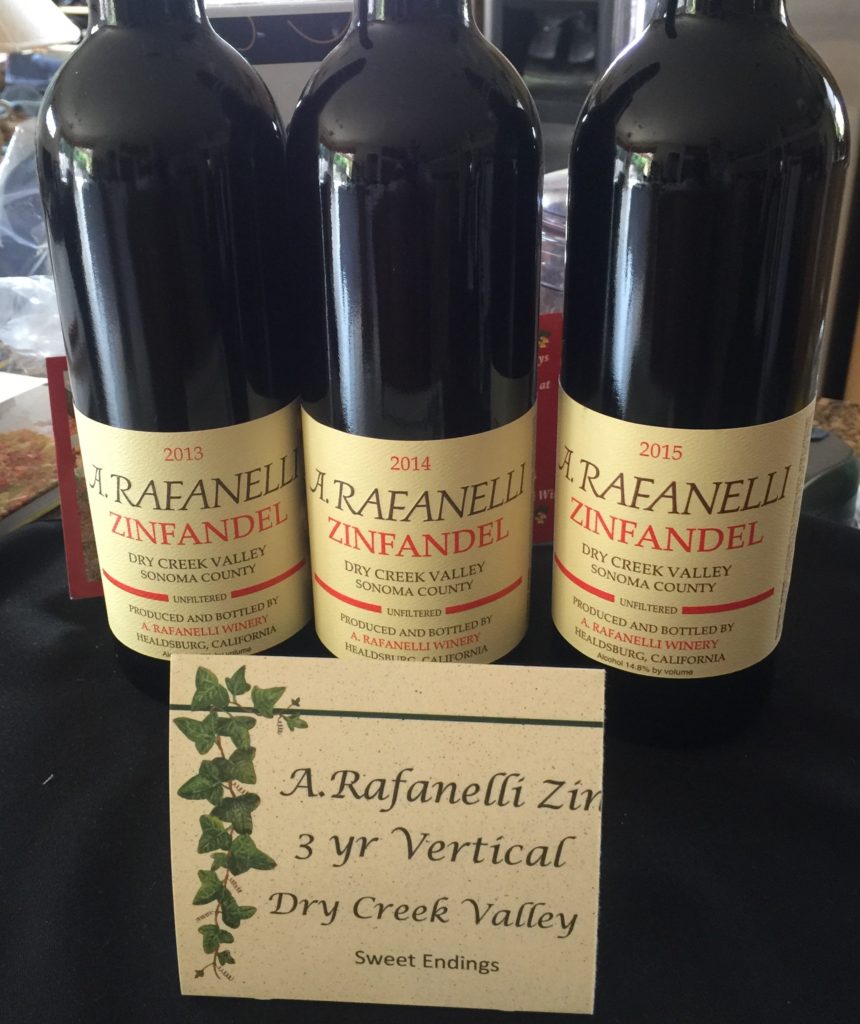
A. Rafanelli Winery
Dry Creek Valley is only 16 miles long and 2 miles wide with little rolling hills and stony soil making it perfect for the gnarly old zin vines growing there. This is the story of a Dry Creek Valley icon.
The A. Rafanelli Winery was begun four generations ago in the early 1900s by Alberto Rafanelli, an Italian immigrant. After the Prohibition, he and his son Americo moved the winery to a knoll on West Dry Creek Road overlooking Dry Creek Valley. They began to farm Zinfandel and raise a family. Their wine was first sold commercially in the early 1970s. Now Americo’s son David and his wife Patty own and operate the business. Their oldest daughter Shelly is the winemaker; her husband manages the 85 acres of vineyards and sister Stacy is in charge of daily operations. They produce Zinfandel, Cabernet Sauvignon and Merlot, and A. Rafanelli Zin is some of the best you will ever taste! Visiting their very rustic laid-back winery is an event in itself. You MUST have an appointment and unless things have really changed since I was there, you must call them. Their wine is very highly allocated! They only make about 11,000 cases a year. Generally you can only buy it at the winery or by phone; however I do see some bottles here and there on the internet. If you appreciate Dry Creek Valley Zinfandel, be sure to spend the time to get on their mailing list. If you ask for a tour of the winery, you can usually get one. We felt honored to have David take us on a tour of their cellars when visiting back in 2007. And you can believe that once I got on that mailing list, I somehow have managed to keep on it every year since! Their Zinfandels are not inexpensive. You can expect to pay between $45 and $55 and a bottle of their excellent Terrace Select Cabernet will set you back $120, not small prices for Sonoma, but worth every penny for A. Rafanelli!
2013, 2014 and 2015 A. Rafanelli Zinfandel, Dry Creek Valley AVA
Rafanelli Zins are all just under 15% alcohol which is perfect for this winelover as we don’t really care for any big 16 or 17% alcohol wines any more, but they are still full-bodied, dark crimson in color with lots of black fruits, licorice and flowers on the nose. Then there are those black fruits, liqueurs, dark chocolate and pepper on the palate. These Zins age well and set a really high bar for any others from Dry Creek Valley. We were anxious to see what little differences we tasted when opening this three year vertical; however by this time of wine tasting so many fabulous Sonoma County wines, I cannot tell you if anyone was even thinking about those little differences. They were just so enjoying the opportunity to drink three vintages of it. Our A. Rafanelli’s came direct from the winery and cost between $43 and $53 a bottle.
2013 A. Rafanelli Zinfandel
2014 A. Rafanelli Zinfandel
2015 A. Rafanelli Zinfandel
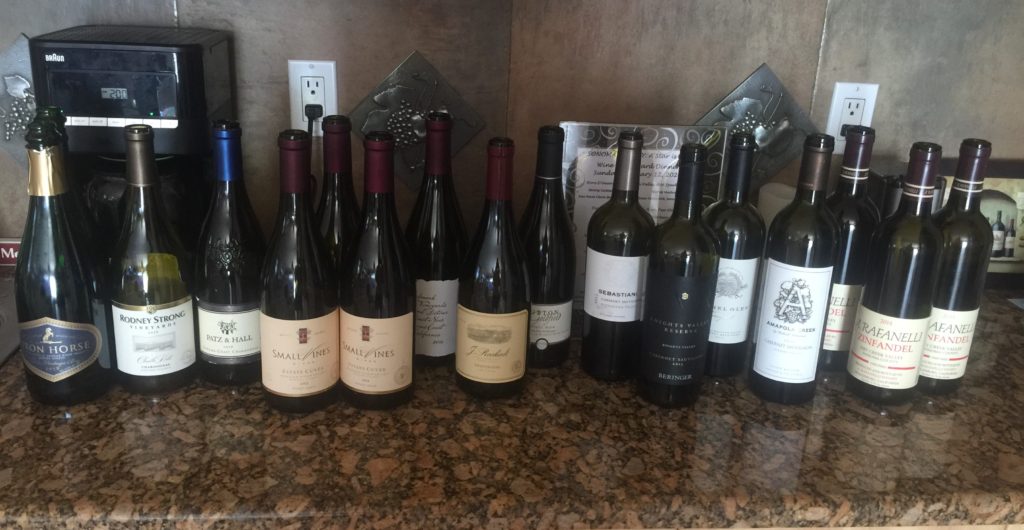
Mission accomplished! Sonoma County – your star has definitely been born! I don’t think there was any doubt after our party of twelve tasted through sixteen Sonoma wines, all shining examples of why this wine region was selected as the “Wine Region of the Year”. No, we did not rate the wines or write down tasting notes as we worked our way through them. This evening was all about enjoying them and their foods pairings. I am sure some would have rated higher than others, but there were definitely no complaints on this special night!

I always take time after an event like this to reflect on the final outcome. Did the guests enjoy the wines? And were the pairings as I had hoped for? And did everyone gain a little more knowledge about the wines as a result of the amount of time invested? Personally, I devote several months to researching, planning, coordinating and preparing such a wine dinner. The knowledge I gain is astronomical! I am happy as long as everyone else gains even a few tidbits of information, tastes some new wines, enjoys the food and most of all, an evening of friendship with fellow winelover foodies. Yes, I think the stars really shone brightly on this night and the mission was accomplished!

It is with tremendous gratitude that I share my appreciation for our guests and my husband who assist by suggesting and preparing foods for our dinner events, serving each course and cleanup, pouring wine, (no I DO NOT have a production and service staff in the kitchen!) and still continue to support me with my sometimes wild and crazy ideas for wine adventures. They are stars in their own right and never cease to amaze me! Here’s to our next adventure, wherever it may take us.
Cheers and Bon appetit,
Linda
If you would like to learn more about the wine region of Sonoma County and all eighteen of those AVAs, here is the link for my last article published in forkandcorkdivine.com surprisingly titled SONOMA COUNTY: A Star is Born. https://www.forkandcorkdivine.com/?p=3222.
1.28.20 LR forkandcorkdivine

